

















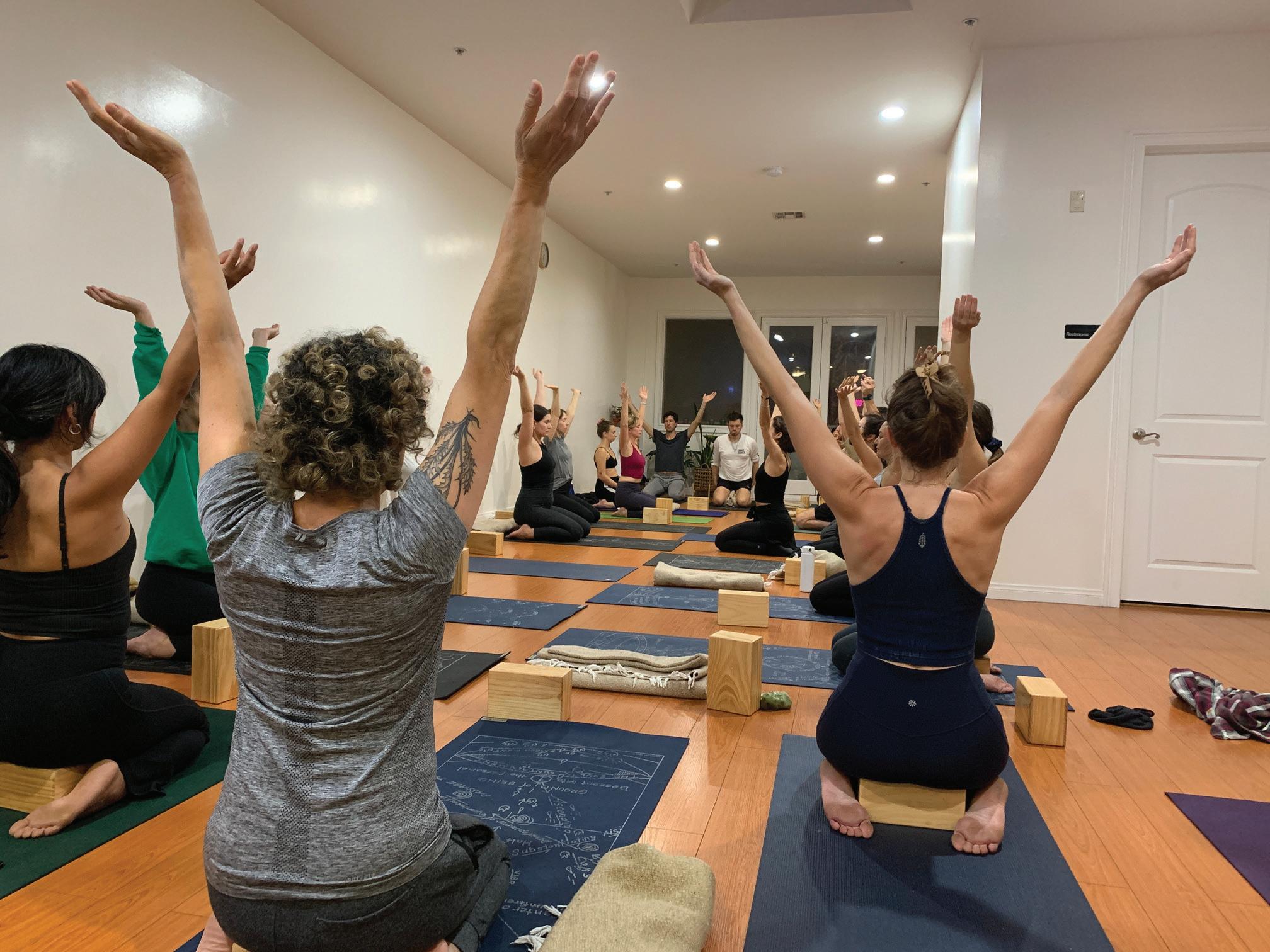


Sara Blumenkranz, the owner of Archetype Yoga, is encouraging everyone to slow down this winter.
Amid a bustling holiday season, this can seem like a near-impossible task. After living in New York City for almost a decade, Blumenkranz sought to create a little piece of that when she opened Archetype Yoga in April.

Nestled on the iconic Colorado Boulevard in the heart of Pasadena’s Playhouse district, the sun-soaked loft has French doors overlooking the San Gabriel mountains and a kitchen where students gather after class to sip tea and commune.
In January, Archetype Yoga will host an in-studio winter retreat that Blumenkranz describes as “a curation of all of our favorite practitioners.”
The day will include a sound bath, restorative yoga, guided meditation, a cooking demonstration and a chance to make personalized tea blends.
“Winter, by nature, is a time of rest, nostalgia and reflection,” she says.
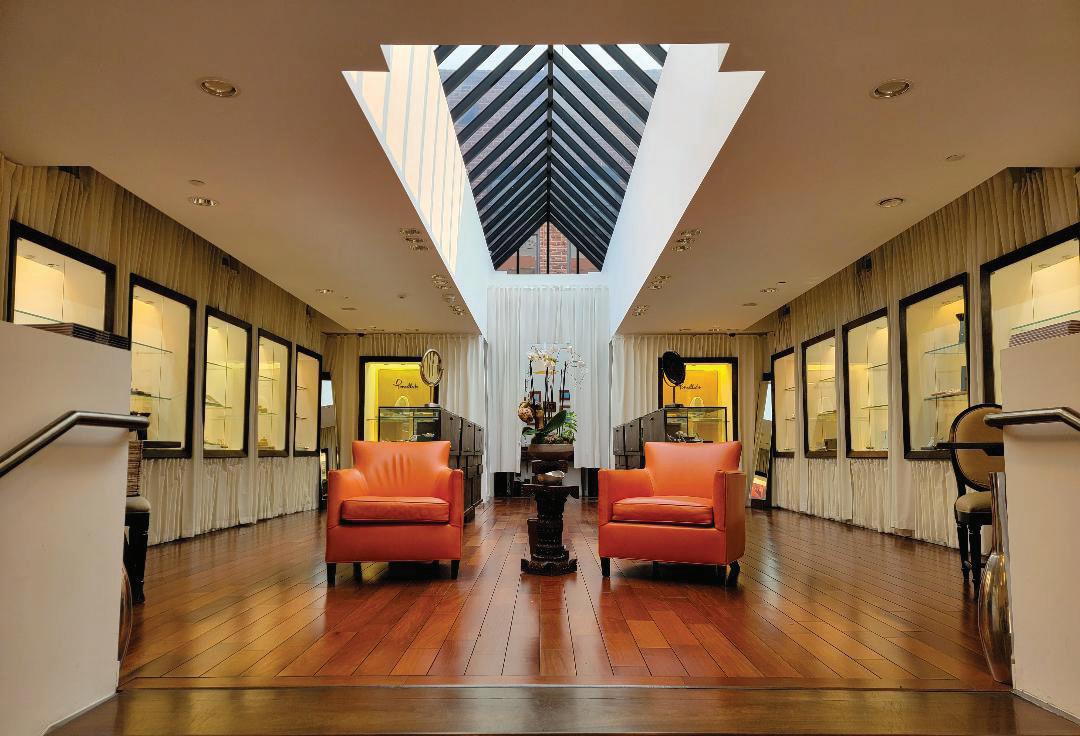

“The goal is not to fight that. Great nature beckons us to reserve our stores of energy in preparation for the burgeoning of spring. So we’ve set up a retreat that is the perfect chance to invest in self-care.”
Archetype Yoga practices Katonah Yoga, a newer yogic lineage created by Nevine Michaan in Katonah, New York, more than 40 years ago.
Since then, it has spread throughout the globe, drawing practitioners with its dynamic mix of hatha yoga, Taoist philosophy and sacred geometry. Katonah Yoga emphasizes alignment and the use of props to aid in the setup of postures. Classes are taught more like workshops with thorough explanations so students can learn “the why” behind the pose. It’s about working the mind and body connection with metaphors, guided imagery and hands-on adjustments to help students visualize the archetype of a pose within the frame of their body.
Archetype Yoga offers a variety of classes, private sessions, Katonah Yoga training and a popular full moon intention-setting workshop.
“This month we will use the momentum of the new year to set our resolutions,” Blumenkranz says. “The full moon workshops include tea, tarot readings, and sound bath or guided meditation. The best part of the experience is getting to know people in a safe and inclusive space.”
This intimate experience is capped at 15 students per workshop, and the reservations go quick.
Other offerings include master classes with exciting thought leaders on the cutting edge of yoga.
“Living in New York, I got to practice with instructors from the Katonah Yoga Center and The Studio NYC,” Blumenkranz says.
“When I opened Archetype Yoga, I couldn’t wait to introduce these integral instructors who supported my progression. I believe that every yoga practice needs to be refueled with insight and master classes drive new thought.”
Archetype Yoga is preparing to unveil its upcoming body lab training sessions with “an amazing instructor,” Cassandra Simons.
“She has spent over a decade honing her craft and communicates the material in a way that makes it easily digestible,” she says.
“Because of this, many are drawn to learn new yoga pedagogy or rehabilitate injuries. These training sessions are geared for students to use the material beyond the mat.”
In less than a year, Archetype Yoga was voted Pasadena Weekly’s Reader Recommended Yoga studio in 2022. (Pasadena Weekly is Arroyo Monthly’s sister publication.)
“For me, it’s more than just a yoga studio,” Blumenkranz says.

“It’s been about connecting people to their bodies. There’s nothing better than helping people realize their power.”
Ultimately, Blumenkranz wants the studio to become a space of learning, engagement and community for all.




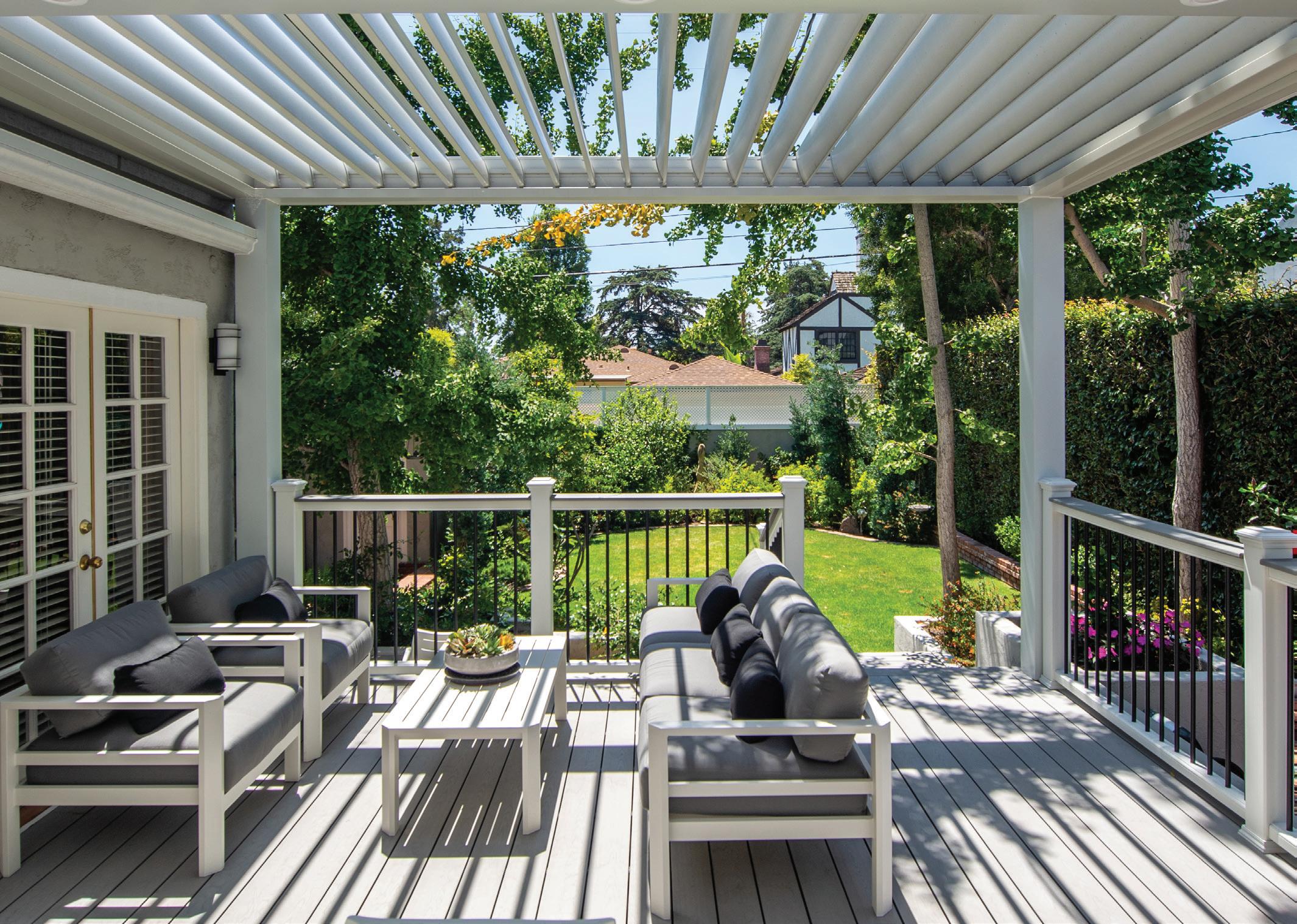



For the wife-and-husband team of Cheri and Erich Ehrlich, their inclusive, energetic, full-sensory workouts are designed to provide the mind-body experience of yoga that everyone deserves.
That belief guides them with their franchise studio, YogaSix Pasadena.

“Our mission was always to build a community that is open to anyone who wants to come in and practice,” Cheri says. “There is a lot of fear when people talk about yoga studios. Many potential students say, ‘I’m not good enough to take a yoga class. I’ve never done it before.’ Our goal is to take the fear out of it.”
The couple opened the studio in October 2021. Previously, they were in the wholesale and retail apparel business. Cheri was an executive at Macy’s for over 25 years and Erich was in the wholesale business in Los Angeles. She says they were looking for a change when they approached YogaSix.
“We stepped back and said, ‘We want to do something great in the community.’ We researched YogaSix and really liked it. It was welcoming to anyone. You didn’t have to have a ton of experience to come in and benefit from doing yoga. That was our big draw to purchasing the franchise.”
The YogaSix franchise is part of a larger company, Xponential Fitness, which shares information through weekly calls, emails and recaps. Fellow YogaSix owners learn from each other. “We meet with other owners to share ideas and help each other out,” Cheri says.
Cheri is a yoga practitioner who started with Bikram yoga about 15 years ago. Yoga is newer to Erich, who underwent a knee replacement several years ago. He has witnessed the benefits of yoga and become more flexible. It even helped his golf game.
Cheri says it was arduous getting the word out about the studio at first. Word-of-mouth advertising has been important. It also helped that they moved into a space previously occupied by YogaWorks.
“Our best advertisement comes from our members,” she says.
“Check out our reviews on Google and Yelp to really understand what the studio has to offer.”
The studio uses lights, music and heat (warm and hot) to create a full sensory experience. The state-ofthe-art practice room is equipped with a UV air filtration system that purifies the air throughout each class.
At the end of each class, students are greeted with a chilled, moistened eucalyptus towel to refresh and relax.
Yoga is known to help with flexibility, strength, stress management, restful sleep, heart health, energy level and mood elevation.
Y6 has its own language formula; it’s its vinyasa-based cueing style that utilizes breath, action, body part, direction and pose name to guide all the movements and transitions in any YogaSix class, creating clear, concise and direct communication with each student.
“We are always talking about the breath and where to place your hands and your feet,” Cheri says. “We build from the ground up so that you aren’t constantly looking around at other students, trying to figure out what you’re supposed to be doing. You’re able to really focus on your practice. In doing that, you can achieve your own personal goals.”
The best part of practicing yoga is practicing with a friend, Cheri says. Many clients attend classes with close friends or groups. Some even make
yoga part of a night out.
“When we first opened, maybe six months in, we had a group of friends who met at the studio, and after yoga, they would go out for dinner together,” Cheri says.
Many members go to the studio multiple times a week. Others take multiple classes in one day.
Yoga has so many benefits; it’s known to help with flexibility, strength, stress management, restful sleep, heart health, energy level and mood elevation.
“Most people fit into these areas, whether they want to build strength, work on flexibility, manage pain, or work on mindfulness and relaxation,” Cheri says. “Depending on their experience and other activities, we provide a road map to assist them in taking their first weeks of classes. We want our members to continue to make progress and achieve their goals.”
When new students arrive for their first class, they are welcomed with their name on the chalkboard. Cheri, Erich or one of the wellness advisers take them on a tour of the studio and introduce them to the teacher.
“We provide that special connection so that the student is set up for success from the very beginning. The teacher helps the student set up their mat, secure the props from the back, and inquiries about any injuries,” Cheri says.
The teachers at the studio range in experience level. Some are newer to teaching, while others have been practicing and teaching yoga for over 10 years. All instructors must have their 200 hours Yoga Alliance training before teaching at YogaSix. They also participate in “bridge training,” where they learn the Y6 methodology. Teachers must be signed off on each of the six class formats before leading a class.
Each of the six core yoga classes has a specific focus and produces specific body benefits.


Classes are available for different experience levels, with varying focuses and temperature levels.

Y6 101
The perfect class if you’re brand new to yoga or looking to ease back into your practice. Vinyasa. Warm room. This is a launching class for other classes.
A slower-paced (but still challenging) vinyasa class, enjoy more time to transition and experience postures as you flow. Warm room, all levels class, fewer postures; more time to hold.
The ultimate recovery class… slow down, stay low to the ground, and open the major muscle groups of the body. Warm room (85-90 degrees). Great counter-class for those doing high-intensity sports or sedentary lifestyle.
Flow, strengthen and stretch in our set sequence in a heated room (105 degrees). Come hydrated. All levels. Type A personality, working professionals. New to yoga, but not new to fitness.
A faster-paced, fun and challenging vinyasa class, you’ll develop strength, focus and flexibility while having fun. Vinyasa style but not a set sequence. Rocking playlist.

The class to build strength, cardiovascular health and endurance by using dumbbells, bands and bodyweight exercises. Fitness focus class.
The studio offers memberships based on the number of days you plan to practice on a weekly basis. There are four times a month, eight times a month and unlimited memberships, as well as an all-access studio pass that allows guests to visit the over 150 YogaSix studios around the United States. There are also single and 10-class packages available.
YogaSix Pasadena 277 W. Green Street, Unit 110, Pasadena 626-788-3848, yogasix.com/location/Pasadena
l

Private day and boarding high school
Learn more about EF Academy Pasadena and apply for our scholarship program by February 1, 2023.

Apply for our Honors Scholarship Program and become a global changemaker.



Melinda Hughes suffered from scoliosis and knee pain until she discovered SuperSlow strength training 15 years ago.
The workout resulted in her feeling more energetic during the day and experiencing a more restful sleep each night. The then27-year-old noticed her chronic pain had disappeared and her back felt much stronger. Her scoliosis also wasn’t as pronounced because she safely corrected muscular imbalances.
“I thought it was too good to be true,” she says.
“But the science made sense to me, based on my studies of the human body as I earned my master’s in nutrition. I took a chance and tried the workout. Right away, I could tell the difference. In only a few months, my knee pain, which was diagnosed as genetic, was completely gone. It was just a matter of strengthening the muscles.”
After working as a strength training instructor at her mentor’s studio, Hughes stepped out on her own and opened The Strength Shoppe in 2011 to bring the benefits of high-intensity strength training to clients in Pasadena. Six years later, she opened a second studio in Echo Park.
Hughes said the slow-motion, high-intensity strength training technique used at The Strength Shoppe is successful because it is safe and effective.

“You’re lifting the weight slowly and lowering it slowly,” she adds.
“You’re not using momentum to lift the weight, so you work the muscles very intensely. You never lock out or completely straighten your joints, and you never set the weight down. From the beginning to the end of the exercise, your muscles are working to the point of muscle failure. Lifting to the point of muscle failure does not allow the muscle to rest, which causes the muscle to become stronger.”
The exercise form works, she says, because SuperSlow causes little tears to the muscle fiber. The muscle, which is attached to bone, tugs at the bone, causing a stimulus to the bone tissue.
“We don’t actually become stronger during a workout,” she says.
“A workout makes us temporarily weaker, and the body’s response to this stimulus makes us stronger. It’s necessary to offer a meaningful stimulus and equally necessary to allow the recovery time needed for the body to repair and become stronger.”
During the rest period between workouts, “growth hormones are released, osteoblasts are released, and the body recovers from the workout.”
But for the recovery process to be most effective, the stimulus provided must be significant.
“It’s like your skin,” she explains. “If you scrape your knee, your skin is going to repair itself pretty quickly. In a day or two, it’s done. If you cut your skin to the bone, it’s going to require more days for the body to repair the skin tissue and heal that wound.”
Hughes said those who use traditional exercise and work out too often without allowing the body to recover are more susceptible to cold, flu, sickness and injury.
She maintains SuperSlow training is perfect for those who want to get the maximum benefit of exercise in a minimal amount of time. The Strength Shoppe trainers work with many clients who are busy parents and those who work long days or travel frequently.
This form of exercise was developed for osteoporosis patients in their 90s and is safe enough for those with medical conditions and injuries.
“Weight training has long been known to be the only way of halting progress of osteoporosis and reversing it aside from medication, but traditional strength training poses too high a risk of fractures for those with low bone density,” Hughes says.
Hughes and her team work with their clients at the Pasadena and Echo Park studios as well as online in virtual appointments on Zoom or FaceTime. The Strength Shoppe clients range in age from 11 to 92. Parents send their children to The Strength Shoppe so they understand how to take care of their body and feel good about it, Hughes explains.
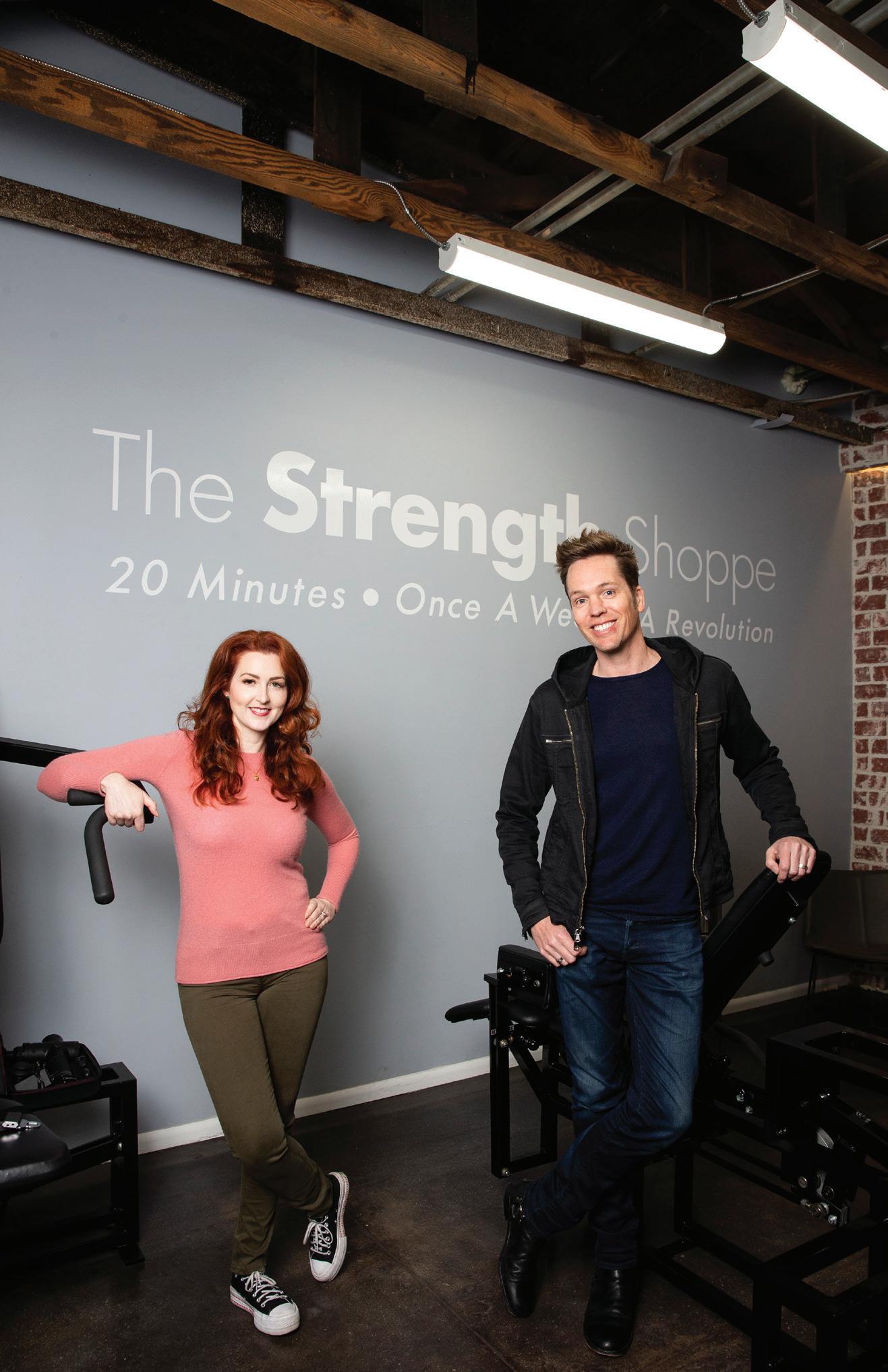
Clients De and Pat Alcorn have been going to The Strength Shoppe since its opening. De remarks that this method of lifting is not something to pass up. There’s “such little time required. At first, I couldn’t believe it. I got stronger and stronger, and I was in my 80s at the time, and I’m 90 now. The Strength Shoppe is something I wouldn’t do without anymore. It’s just made a big difference. Without it, I think I would be a lot less healthy than I am right now.”
Pat agrees.
“I’m not one for exercise,” Pat says. “So, it started out with me not being very enthusiastic. But I feel that it has been such an important thing in my life. It’s almost like a physical therapy session for me, so I wouldn’t miss it.
“I’ve had a couple of health setbacks in the past couple of years. When we first started, I was gaining strength, especially in my upper body. The trainers were able to work around my health setbacks, and it helped me recover quickly.”
De says Hughes is a wonderful person to work with, and the trainers are excellent.
“They’re very patient, thorough, easy to work with, cognizant of our condition, and attentive to their clients. And they’re just very friendly people and professional,” De explains.
SuperSlow training is based on scientific research.
“Doctors advise their patients to try strength training before knee replacement surgery,” Hughes says. “The healing after the knee replacement surgery goes better if you’re stronger. The after care is easier.”
Client Pam Craig says she came to The Strength Shoppe “using a cane to walk. I couldn’t stand without pain in my knee. Now it’s years later, I still come every week. I walk without a cane. I stand without pain. I still have almost no cartilage in my knee, but the stronger lower body muscles compensate. This training has literally saved me.”
According to two separate studies conducted by renowned fitness researcher Dr. Wayne Westcott, “slower repetition speed may effectively increase intensity throughout the lifting phase while decreasing momentum.”
Westcott and his team of researchers concluded “in both studies, SuperSlow training resulted in about a 50% greater increase in strength for both men and women than regular speed training.”
Furthermore, due to the safety of slow movements, “SuperSlow training is an effective method for middle-aged and older adults to increase strength.”
Lifelong lifter Blake Boyd turned to The Strength Shoppe after experiencing neck pain in 2018. Boyd asserts, “It didn’t
happen overnight, but after a couple months of strength training one day a week, my neck has never hurt since. It’s very cathartic work. Physically, it’s also very safe because you’re going super slow.
“I had both my hips replaced. That was two years ago. My trainer and I figured it out about six months ago that since the surgery, my lower body strength is up about 30%, and I’m 56.”
For further education, Hughes uses her Master of Science in holistic nutrition to create educational workshops and courses with her husband/co-owner, Arjen van Eijmeren, to offer clients of The Strength Shoppe a one-stop shop for all things health related. Clients access these programs through an online portal.
“Our goal is to help people expand the physical capability of their bodies so they are able to do all the things they want to do in their lives,” Hughes says.
“Your body shouldn’t limit you. Your body should give you the strength and ability to achieve your full potential and live your best life.”
The Strength Shoppe 350 S. Lake Avenue, Suite 105, Pasadena 305 Glendale Boulevard, Los Angeles thestrengthshoppe.com
The use of chia seeds in the diet has grown in popularity in the last few decades. It’s a nutritious seed that can be added to coffee, drinks, puddings, desserts and lots of other foods.
Inez Ainge wrote in an article, “Native Chia” (1967), that “chia has been proclaimed a high-energy food not only because it contains a high percentage of protein (30%), but because it also contains a natural enzyme which acts as a catalyst for the protein.”
A nutritional analysis done in 1964 shows 20.2% protein, 34.4% oil and 5.6% ash, as well as significant amounts of iron, calcium, phosphorus, magnesium, potassium and traces of other minerals common to most seeds.
This golden chia is a native to Southern California and the Southwest generally, and it is not the chia commonly sold in all health food stores, so
let’s try to clear up that confusion.
Golden chia — salvia columbariae — received significant public attention in the 1950s and ’60s, due to the writing of Harrison Doyle, mostly in Desert magazine.

He authored the self-published book “Golden Chia: Ancient Indian Energy Food.” He also cultivated the seed for sale, and encouraged others to do so. Doyle writes, “As a boy in Needles, California, I played with the Mohave Indians my own age. I ate their foods, ran long-distance races with them, rode their colorful Indian ponies bareback, whacked a tin can around the yellow silt flats in the ancient game of shinny. I remember some of the Indian boys telling me (I was interested in long-distance running at the time) that Indian runners sometimes ran all the way to the coast on trading expeditions with the Coast Tribes, carrying gourd shells containing water and a handful of chia seeds to sustain them.”
Harrison also frequently mentioned the writing of Dr. J.T. Roth-rock, botanist and surgeon of the Wheeler United States Geographical Survey of 1875. Rothrock wrote that the chia was cultivated as regularly as corn by the Nahua races of ancient Mexico.
Of the seed, Rothrock writes, “An atole, or gruel, of this was one of the peace offerings to the first visiting sailors. One tablespoon of these seeds was sufficient to sustain for 24 hours an Indian on a forced march.” Harrison pointed out that this was most likely referring to Indian runners and traders in the desert Southwest.
As a result of the writings of Doyle, health food stores wanted to provide the seeds to their customers.
Though there had been some attempts to cultivate the native chia, a related plant, salvia hispánica, had already been in production in Mexico, and so this was the readily available seed that met the demand from health food stores. To this day, salvia hispánica is the majority of the “chia” that is sold in markets. Salvia hispánica seed resembles a tiny mottled pinto bean, usually dark gray or black but occasionally gray or nearly white. The native golden chia — S. columbariae — has a brownish or goldish-tan seed that is almost pyramidal in shape. Both seeds will form a gelatinous outer layer when soaked in water, nearly white.
Most objective studies indicate that whether you’re using the commercial chia (salvia hispánica) or whether you’re one of the rare ones who either grows or collects their own native chia (S. columbariae), you’ll be getting a top-quality nutritional seed either way.
Doyle reported in his book that he conducted several tests on himself of the native vs. the non-native commercial chia seeds. In general, he says, the golden chia seed produced a pronounced feeling of excess physical energy that he didn’t experience from the nonnative seeds.
Indigenous people of the Southwest collected the seeds by bending the stems of the mature plants and shaking them into a finely woven basket. In a solid stand of the plant, a surprisingly large amount can be gathered in a short time. When I locate such a place, I usually just shake the heads into a small plastic collecting bag. You can then shake the seeds through a fine mesh screen to remove all foreign particles.
The seeds can be made into drinks by simply soaking for a few minutes in either hot or cold water or fruit juice and drinking as is. I add about a teaspoon to my daily coffee.
Almost tasteless, the seeds, when so used, are inexplicably refreshing. The Pomo Indians ground the seeds into meal and used as flour for small cakes or loaves. Today, many people mix the chia flour half and half with wheat flour to make bread. The seeds, like any other edible seeds, can also be sprouted and eaten as a fresh vegetable.
For dishes such as cereals, mush and soups, add two tablespoons of seeds per cup of water. As the mixture warms (chia doesn’t need to be cooked as do most cereal grains), the water will become mucilaginous. This tapioca-like food can be eaten as it is (or sweetened to taste with honey) or can be added as a smoothening agent or extender to pancake batter, biscuits, bread, ice cream, pudding, coffee, cold drinks and more.
The seeds, when eaten, are useful in gastrointestinal disorders and as an emollient. When drunk in tea or eaten, the seeds also aid bronchial and throat troubles. The seeds can be crushed between the fingers to produce an oil (generally called chia oil) for the skin.
Daniel Moerman, in his monumental “Native American Ethnobotany,” describes many of the edible and medicinal uses of the native chia. Among the Native Americans of northern New Mexico and southern Colorado, a decoction made from the fresh or dried leaves has been used to relieve stomach troubles. The fresh leaves of all members of the mint family, including chia, abound in volatile oils contained in resinous dots in the leaves and stems.
Mostly oblong-ovate in overall outline, each leaf varies from one to several inches long. Each leaf is bipinnately divided; that is, the margin is indented into segments along a common axis, and each segment is further pinnately divided. The leaf surface is finely wrinkled and covered on both sides with tiny fine hairs. The leaves, mostly basal, grow in opposite pairs — generally two or three pairs of leaves per stalk.
The small, typical mint-family flowers are blue, two-lipped, about half-inch long, and clustered into round whorls along the stalk(s). There are usually one to four whorls per stalk, with numerous sharply pointed purplish bracts at the base of each whorl. The plant is usually in flower from March through June, though sometimes a few random plants will be found flowering into summer.

The seeds are best collected in July and August when recently matured, but before strong winds or rains have shaken them onto the ground.
Golden chia, salvia columbariae, is native to California and is commonly found in the high-desert regions (1,500 to 4,000 feet elevations). The
plant is found in the deserts, chaparral areas, foothills and yellow pine belts of California, Nevada, Utah, Arizona and New Mexico.

The commercial chia (S. hispánica) is native to Mexico and South America.
Christopher Nyerges is an educator and author of 22 books, several of which have chapters on the native chia plant. More information can be found at schoolofself-reliance.com.
Owners Nader Kaiser and Gustavo Landgrebe had a vision when opening their Italian restaurant, Marina Pasadena, in September: to create a neighborhood gathering place where customers can enjoy good wine and flavorful food.

“It’s not just the simplicity of ingredients but the quality of the ingredients,” Kaiser says. “We are honoring the beauty of Italian food.”
Kaiser, who was once the beverage director at Mi Piace, is also the owner of Republik Coffee Lounge, while Landgrebe once owned 1810 Argentine Restaurant and Tasca Wine Bar in Los Angeles.
“Him and I were foodies for years,” Kaiser says. “We’re good at it and love it. We are picky about what we do.”
Kaiser also holds a diploma from the Wine and Spirit Education Trust and is certified as a sommelier by the North American Sommelier Association and the Italian Sommelier Association. At Marina, there are 120 wine labels from California, France, Italy and Spain to pair with a meal. There is also a Wednesday special with 30% off any bottle of wine.
“I have traveled to 20 regions throughout Italy and worked in the vineyards,” Kaiser says. “You fall in love with the different regions and their cuisine. That’s why wine plays a role.”
The interior design of the restaurant aimed for a comfortable yet stylish vibe, with a high ceiling, classic chandeliers, murals representing Pasadena, an open kitchen and a wine room.
“We are accommodating and love to make friends with our guests,” Kaiser says.
Menu items have a rustic Italian foundation prepared by chef Dylan Stage. For starters ($17 to $22), customers can order items such as the octopus marinated with market peppers, shallots, sherry vinaigrette, sea salt and extra virgin olive oil; salt cod brandade with semi-dried heirloom cherry tomatoes and black olive grilled country bread; fried calamari and artichoke with parsley aioli and lemon; and the most popular dish, the market salad, currently with delicata squash, persimmon, ginger, orange segments, whipped goat cheese and orange vinaigrette.
“Dylan uses what’s in season from the farmer’s market,” Kaiser says. “It’s like an explosion of flavors.”
Pizzas ($21 to $25) are also a favorite, including the mortadella and pistachios with bechamel sauce, mozzarella and wild arugula; prosciutto San Danielle with heirloom cherry tomato, mozzarella, wild arugula, shaved Parmesan and crushed red pepper; margherita with tomato sauce, mozzarella, caciocavallo, burrata, basil and extra virgin olive oil; and the house Italian sausage with tomato sauce, mozzarella, caramelized onions, agrodolce and shishito peppers.
“We make the sausage in-house by grinding and cooking it with flavors
that complement the sausage,” Kaiser says. “We also use a soft white Sonoma wheat flour.”
Pasta lovers ($19 to $38) can order the seafood linguini with little neck clams, Mexican blue shrimp, black cod and calamari cooked in saffron seafood broth; ricotta and squash tortelloni with lemon beurre blanc, oyster mushrooms, spigarello and pecorino; tagliatelle rabbit bolognese with tomato sauce, basil and Parmesan; and the bestselling bucatini carbonara with house pancetta, 140 F sous vide egg and Parmesan.
“In the Verona region (of Italy), they eat a lot of rabbit, fowl and duck,” Kaiser says. “(For the carbonara), we make the pancetta in-house, and it cures for 40 days.”
Main courses ($31 to $58) include the cider-glazed black cod with parsnip quinoa, roasted turnips, fermented apples and turnip greens; sautéed veal liver with parsnip purée, caramelized onions, house pancetta, capers and sage; the 12 oz. Wanderer Wagyu New York steak with watercress purée, grilled eggplant, pickled pepper and vermouth sauce; and the 16 oz. Duroc pork chop with cranberry and romano beans, grilled shishito peppers, radicchio and kombucha sauce.
“The quality of the pork chop is out of this world. It’s so tender and flavorful,” Kaiser says.
Kaiser says he appreciates the support of the community and plans on being in the area for years to come.
“Our passion and love for the business in uncompromised,” Kaiser says. “We celebrate good occasions, and we plan on being here for the next 30 years.”


Marina Pasadena
WHERE: 841 Cordova Street, Pasadena

HOURS: Closed Monday and Tuesday; Sunday, Wednesday and Thursday from 5 to 9:30 p.m.; Friday and Saturday from 5 to 10 p.m. INFO: marinapasadena.com

The beginning of a new year signifies a fresh start, and for many of us that includes updating our homes for a refreshed look. Right after the holidays, budgets can be tight — but fortunately there are many ways that you can upgrade your home without breaking the bank.
“A new year is all about a fresh start, and after all the holiday décor comes down, your room can feel dark and empty,” says Amy Peltier of Amy Peltier Interior Design & Home in San Marino. “By refreshing your space, you’ll be able to bring your room back to life. Organize and declutter. Reimagine a new room layout. Add some color and some greenery. Romanticize your refresh and fall in love with your living space again.”
Sarah Barnard, a WELL and LEED accredited designer and creator of environments that support mental, physical and emotional well-being,
adds, “The new year is an excellent time for a fresh start when many people set new goals or want to examine their lives for opportunities for improvement or change. Refreshing our spaces can help us break from routine and familiarity, which may encourage a shift in perspective and mindset. These changes can be beneficial on their own or supportive of introducing new habits. For someone who wants to cook more at home, making changes to a kitchen space, improving storage or finding new ways to open up counter space may help encourage those habits by helping to optimize those routines.”
The new year is a good time to refresh your look because, even in California, it’s a time of year when we are going to be spending more time outside, says Christine Kobervig Munger, vice president of merchandising and sourcing at Fernish, the rental furniture subscription service on a mis-
sion to make it as effortless as possible to create your home.
“Everything looks beautiful when there’s a ton of light streaming through and there’s a fresh breeze coming in from an open window,” Munger says. “When it’s a bit darker you tend to make choices that are a bit less frivolous and more evergreen. While you may be more inclined to buy ice cream or a convertible on a sunny day, when it’s a bit chillier your purchases tend to be more about comfort, which is advantageous when you are thinking about your home. It’s also a good way to help kick-start resolutions to say, get more organized or read more.
From decluttering and organizing to sourcing vintage items and renting furniture, experts share budget-friendly tips for updating your home in 2023.

“If one of your goals is to elevate
your home without spending a lot, I recommend focusing less on updating high-ticket items like furniture, window treatments and rugs,” Peltier says.
“Focus more on updating your style and color palette through accessories, throw blankets and pillows. In fact, we’ve recently launched Pillow Addict to help customers with this dilemma.
Pillow Addict is an eCommerce pillow cover subscription service that allows you to change out designer pillow covers every three months so you can refresh your home every season. Choose from different collections; mix and match as your heart desires; then, when the new season hits, return and swap out ‘last season’s’ pillow covers for brand-new ones. This is the simplest way to elevate your home without having to pay those luxurious price tags.”
Barnard also suggests choosing a few pieces that will enhance the over-
all look of a space.
“Selecting a few elevated items can help upgrade a room’s entire aesthetics,” Barnard says. “A beautiful, well-made throw blanket can enhance a bedroom, or a well-crafted rug can tie together a living room space. A beloved work of art can transform a wall or help specific colors in a room become more vibrant or recede to create more balance. Investing in a few eye-catching items with a significant visual impact helps shift the overall look of a space without needing to upgrade every piece of furniture or décor.”
“Sometimes the biggest impact you can make is not by what you add, but by what you get rid of—and oftentimes that’s clutter,” Munger says. “Two areas that tend to benefit the most from low-budget organizing solutions are the entryway and kitchen.”


Benches are one of Munger’s favorite pieces for the entryway in a home.
“For the entryway I’m a big fan of benches—they’re great for pulling off boots, setting down groceries, neatly tucking shoes in underneath or at the very least, creating a central deposit zone for things that need to go elsewhere. Fernish has some great benches with integrated storage like the Brucia bench, which has an upholstered seat and is one of my
go-tos for anything multi-functional. If you want people to sit on it, it’s got to be comfortable. Bouclé is super on trend right now, comfortable and works beautifully on an item like a bench. So if you want something a bit more modern, the Briar bench is a great option which also looks quite elegant placed at the foot of your bed.”
When it comes to kitchens, Munger recommends streamlining your culinary clutter.
“Kitchens are such high-traffic, high-use areas that it’s always a challenge not to have items stack up on counters — especially if your cabinet space is limited,” she says. “We use our kitchens so much that it’s sometimes hard to notice how seriously cluttered they’ve become. For kids’ art or important reminders you want to display beyond digitally, I’m a big fan of your mother’s old trick of Scotch tape on the fridge. Get it off the counter and onto a wall somewhere.”
Bottles of liquor or nonalcoholic spirits or mixers can take up a lot of space, especially after the holidays, and it’s amazing how much can fit in a bar cart. There are a ton of great options out there that will multiply your counter space immediately. Some are open; others have an armoire-like design. Even a low-profile addition like the Perrier Bar Cart, which is a classic bar cart with wheels, can be a great piece to help clear space. We’ve
also seen a lot of customers combine it with plant storage. For something more substantial, the Cheney Bar Cabinet has a great, midcentury ‘Mad Men’ vibe and has plenty of room including a fold-down surface area for mixing drinks.”
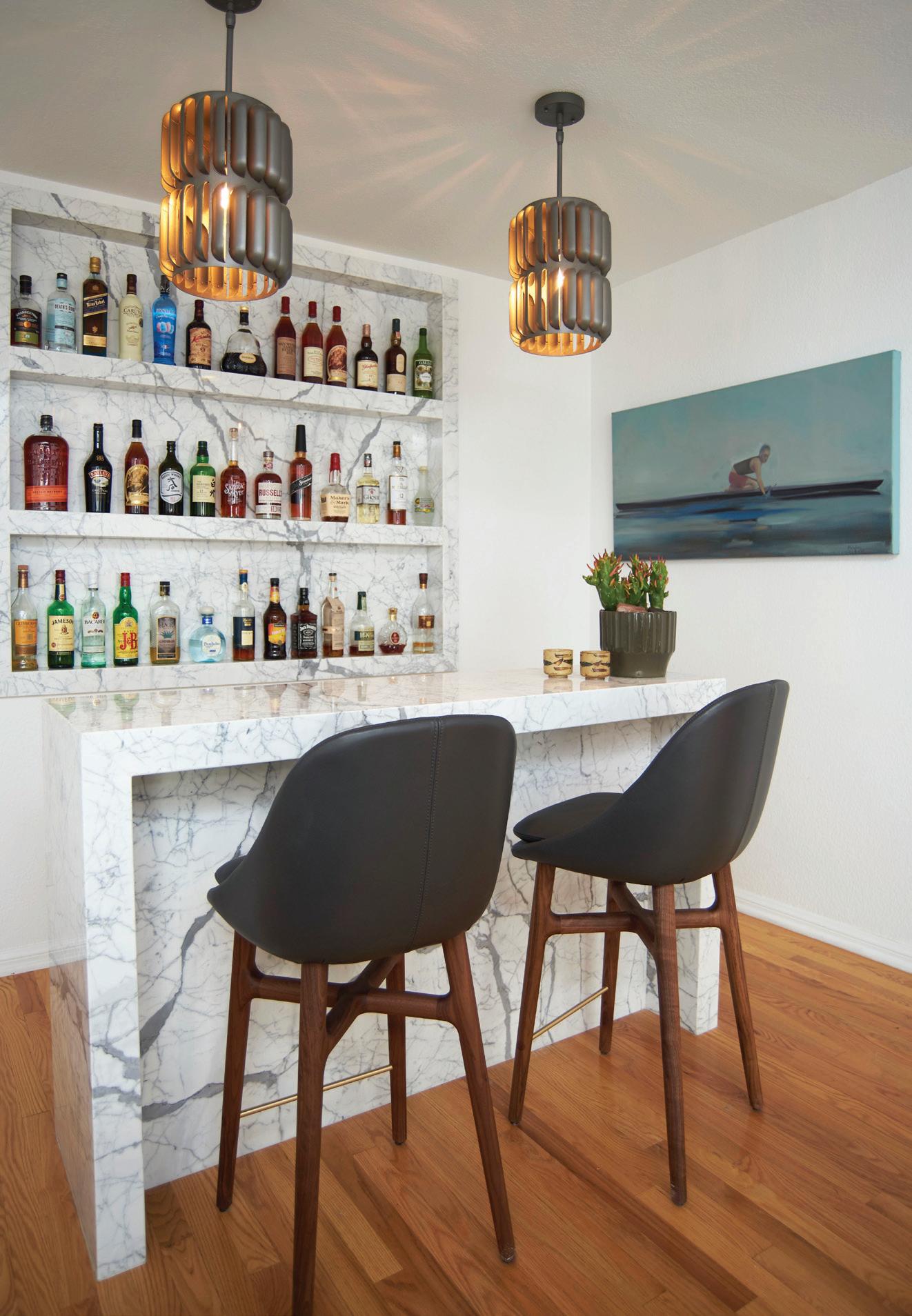
Barnard adds, “Reorganizing is one of the simplest and best ways to make your home feel more open, functional and refreshed. Taking time to tidy and develop new systems will help minimize clutter and create more space to enjoy. Organizing can also make time and opportunity for updates like rotating toss pillows or swapping out linens and textiles to introduce new colors and patterns to the home throughout the year.”
“It’s amazing what artwork can do, and you absolutely don’t need to break the bank to make a wall look fabulous,” Munger points out. “A gallery wall looks a lot harder to
do than it actually is, and there are plenty of tutorials on social media to get you started. You can throw kids’ artwork, photos, album covers, concert posters or even pages from an old magazine into a collection of inexpensive frames to create a cohesive, eye-catching collection. Opt for matter frames and avoid images on glossy paper for a more elegant look.”
For those who are feeling more adventurous, Munger recommends some fantastic eclectic wallpapers from places like Chasing paper, which can create an incredibly luxe feel and can often be installed with peel and stick.
“In my opinion, inviting and comfortable is synonymous with luxurious,” Munger says. “You can easily update your space in this way with new throws and pillows. It’s amazing what a difference a pop of
color, some new texture and a bit of fringe can do to an older sofa or chair. Plus, there’s nothing more inviting than a soft new blanket. Some of my favorites to create layers of textures are the Candace Throw Blanket, Onyx Throw Pillow and Everly Camel Velvet Pillow.”
Give your items new life “Refreshing existing items can be an excellent way to update the home without investing in new items,” Barnard says. “Reupholstering a favorite chair, painting a table (or stripping paint and staining) can give the home a new look. Replacing the legs or feet of dressers and tables, and hardware like knobs and handles, can be a small change with a big visual impact.”
When it comes to finding the perfect pieces for your home, there are many different options, from vintage shopping to furniture rentals. Peltier says visiting local showrooms is the best way to see items in person and assess their quality.
“Of course, the internet has brought all kinds of manufacturers and vendors to anyone’s fingertips, but it can easily feel overwhelming,” Peltier says. “If you’re looking to see good-quality items in person, tap into your local showrooms. For example, our showroom in San Marino has wonderful fabrics, décor and accessories that are perfect for any room refresh.”
Barnard is also a big fan of buying vintage and shopping local.
“Many high-quality vintage items are available at a lower price than their contemporary counterparts,” Barnard says. “In addition to often having financial benefits, buying vintage items is a sustainable way to make home updates. Vintage shopping usually involves more organic browsing than when buying new, which may lead to more opportunities to stumble upon unexpected items for innovative design. Many artist fairs may also feature craftspeople who offer furnishings and décor for specialty items made locally.
When shopping online or through distant shops, many people neglect to factor in shipping, handling and assembly costs, which may minimize any perceived deals from shopping from these locations. Buying from local vendors can help save
on shipping costs and offer more flexibility when purchasing items. Local craftspeople or artisans may be more likely to provide support or customization, which can make a big difference in long-term costs. While upfront pricing may not always be less, building relationships with local artisans may be beneficial when the pieces eventually need repair or updating and can avoid the need to replace certain items.”
Another option that doesn’t always immediately come to mind is renting furniture. Munger says that she came to Fernish because she believes that rental furniture is the future.
“There’s so much waste and expense in moving, and I love the idea of finding pieces that work for as long as you need them and returning them when you move or your tastes change,” Munger says. “Because our model is about refurbishment and reuse, I’m a big fan of vintage pieces and have found some of my favorite pieces that are a little more unique that way.
Most people might not know that like fast fashion, fast furniture creates a tremendous amount of landfill waste. Nearly 10 million tons of furniture end up in landfills every year. We need to break ourselves of the habit of buying cheap, disposable items that won’t last and end up curbside. We do a year-end report every year, and in 2022 we’ll have saved 522 tons of furniture from landfills with people choosing rental over buying that’s equal to the weight of the Statue of Liberty, the Hollywood Sign and an airplane combined.”
Munger shares that there are five main aspects to furniture: upfront cost, delivery, assembly, moving and flexibility. In terms of upfront cost, with Fernish you are only paying for the item for as long as you need it, and Fernish also offers free delivery in as soon as seven days and free assembly.
“In 2022 we saved customers $3.1 million on delivery fees and $400,000 on assembly,” Munger says. “Moving furniture, once you get past the age of bribing a friend with a truck, pizza and beer, is expensive and one of the most arduous tasks to deal with at a time in your life when you are going through a lot of change. If you are living in a market we service, we’ll move your Fernish items for you. We also



Reorganizing and decluttering are some of the best ways to refresh a space and make your home feel more open and functional.
have free three-day swaps, so if you bring something home and decide for whatever reason it doesn’t work, we’ll take it back.
The other big piece is flexibility. With more people working remotely and especially Gen Z and the rise of the digital nomad, more and more people can work from anywhere. That leads to some pretty tremendous flexibility, great experiences, and lots of time to experiment and try out different places you may want to live. There’s an incredible simplicity in renting for as long as you need it and returning when you don’t. You get to be comfortable and flexible.”
For those in need of ideas and inspiration when giving their home a refresh, Peltier looks to various sources including magazines, Pinterest and Instagram.
“Design inspiration is everywhere,” Peltier says. “Instagram is great for beautiful photos and different themes for spaces. Pinterest is also amazing for browsing product ideas as well as beautiful photos.”
In addition to designer portfolios, design magazines and antique stores, Barnard also loves to look outside of traditional design venues for home inspiration.
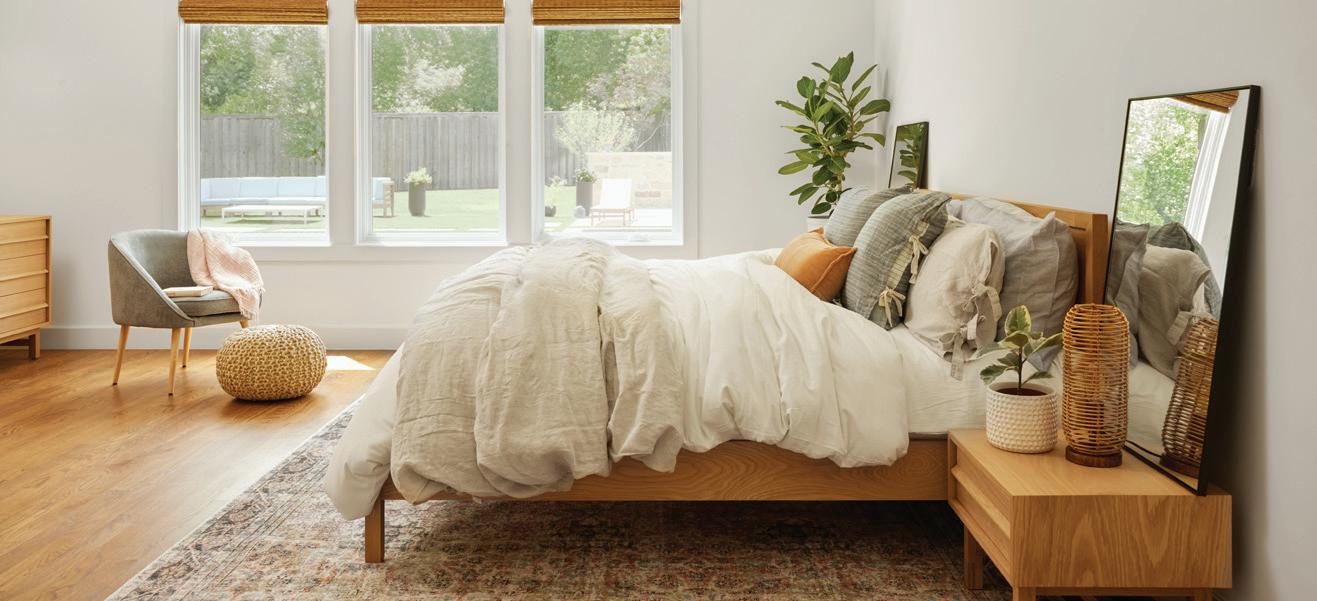
“Seeing images of designed interiors can be inspiring for envisioning different layouts or combinations that would not have been previously considered,” Barnard says. “Seeing the familiar silhouette of a favorite chair in a new context while flipping through a design magazine may spark ideas. On walks, hikes or in the garden, there may be a color, texture or pattern that is striking or beautiful, and finding ways to replicate that in the home can be an exciting and enjoyable process. Looking at art can also be a great source of inspiration for considering colors, patterns or textures that work in harmonious and surprising ways. Seeking unexpected sources of inspiration may lead to more exciting or unpredictable design solutions for the home.”

Munger is also a big fan of Google Lens as another source for design inspiration.
“You can literally search anything you see and it will guide you to shop for it,” Munger says “The accuracy of the technology is just incredible, and it opens up tremendous possibilities in terms of how you can bring what inspires you into your living room. In my experience, if you see something you like anywhere — someone’s home, a restaurant, etc. — people are very flattered, and if they remember, they are usually more than happy to let you know where they got it.
“Social media is also a great place for inspiration and ideas, so I follow a lot of interior designers on Instagram, like @chrislovesjulia, Kate Marker Interiors and @ studiodiy. I also use TikTok to search for items I’m thinking about, like ‘storage bench,’ and you can find all kinds of great ideas including relatively easy DIY solutions.”
Amy Peltier Interior Design & Home peltierinteriors.com
Fernish fernish.com Sarah Barnard sarahbarnard.com
The twice-baked biscotti cookie is versatile and practical.
Stores have a variety from simple almond biscotti to chocolatedipped treats filled with nuts.
This recipe is by no means traditional, with lemon zest in the dough and a chocolate coating outside as the final touch, but the texture is the hallmark of this cookie. That brings us to the practicality of this treat.
Baking biscotti twice means that they are very dry, making them more shelf stable and easier to wrap up for a lovely home-baked gift. No matter how many variations there are, biscotti will always remind me of my grandmother. Sometimes after school we would talk or just silently enjoy the afternoon as we dipped biscotti cookies in Lady Grey tea.
Thus, in my mind, biscotti are for sharing and enjoying with others. I hope you will be able to make a memory with your loved ones over chocolate-dipped lemon zest biscotti, too.
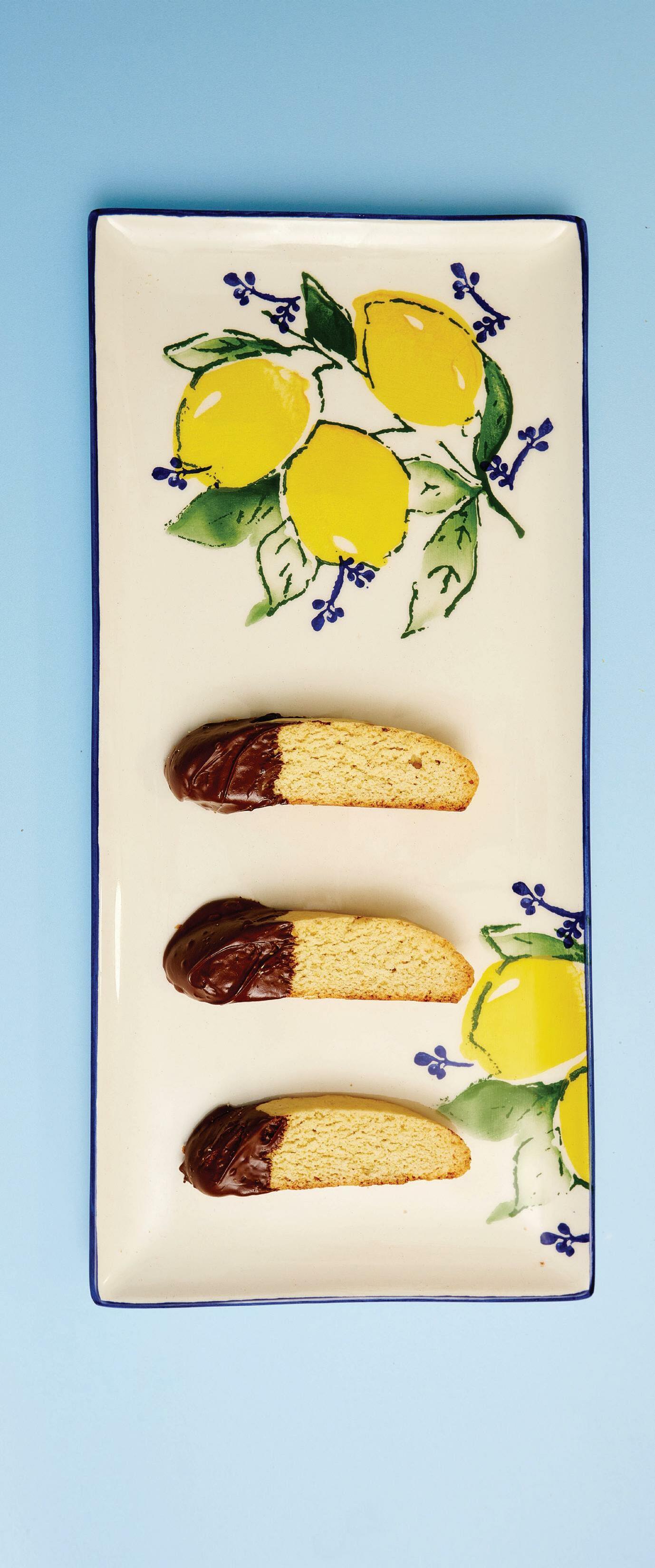
BEAT BUTTER AND SUGAR TOGETHER UNTIL CREAMY WITH AN ELECTRIC MIXER.
ADD EGGS AND VANILLA EXTRACT AND MIX UNTIL COMBINED.
IN A SEPARATE BOWL, WHISK TOGETHER FLOUR, BAKING POWDER, SALT AND LEMON ZEST.
ADD DRY INGREDIENT MIX TO CREAMED BUTTER AND SUGAR. MIX ON LOW SPEED UNTIL FULLY COMBINED.
DIVIDE DOUGH IN HALF. SHAPE EACH HALF INTO A LOAF ABOUT 8 INCHES LONG.
PLACE BOTH DOUGH LOAVES ONTO A PARCHMENT PAPERLINED BAKING SHEET. GENTLY AND EVENLY SHAPE LOAVES UNTIL THEY ARE ABOUT 3/4 INCH THICK.
BAKE AT 350 DEGREES FOR 20-25 MINUTES UNTIL LIGHTLY GOLDEN AND THE CENTER OF THE LOAVES SPRINGS BACK INTO SHAPE WHEN TOUCHED.
LET LOAVES COOL ON THE BAKING SHEET FOR 30 MINUTES. USING A SHARP KNIFE AND PRESSING DOWN IN ONE SMOOTH MOTION, SLICE THE LOAVES DIAGONALLY TO CREATE THE BISCOTTISHAPED COOKIE.
PLACE BISCOTTI ON THE BAKING SHEET WITH THE CUT SIDE UP. BAKE FOR 12-16 MINUTES, UNTIL DRY. THE EDGES WILL BE SLIGHTLY SOFT WHEN WARM AND WILL BECOME CRISPER AS THEY COOL.
USING THE DOUBLE-BOILER METHOD, MELT THE CHOCOLATE CHIPS. REMOVE FROM HEAT AND DIP BISCOTTI IN THE CHOCOLATE, THEN PLACE IN THE REFRIGERATOR FOR A FEW MINUTES TO LET THE CHOCOLATE HARDEN.
At Valerie Confections’ new Glendale location, hundreds of tiny chocolates, toffees and truffles are perfectly arranged waiting to be sampled by customers. Jams and ready-packaged holiday confections sit atop recycled walnut shelves to be chosen as a perfect gift.

In the back, employees are hard at work baking pies and decadent eggnog cakes for the holiday party season. Everything at Valerie Confections is made in-house, from the peppermint candy that tops its popular peppermint bark to the candied flowers that top its cakes.
The new location is the primary production and shipping facility for all orders across the country. The property also has room for classes and tastings, and indoor/ outdoor event spaces. In the latter, owner Valerie Gordon hopes to grow some of the produce used in their baking process and edible flowers.
Gordon and her partner, Stan Weightman Jr., see the bakery as a place where their team can “be inspired, be creative and feel refreshed.” The pair started the bakery in 2004 after the gift baskets Gordon created for her friends and family became increasingly elaborate.
Gordon began making sweet treats as a kid, starting with cookies and gradually evolving into more and more complex projects.
“Anything I ate as a kid that I liked, I thought, ‘I want to make that.’ And because I love toffee, toffee became the big thing (I made),” Gordon says.
Toffee is a signature treat and one of the confections she has experimented with the most. Gordon says she felt like toffee has always been treated so informally by other chocolatiers, who often toss it into boxes and favor the presentation of more sophisticated confections, such as truffles.
“I thought, ‘What if I take this American confection and apply the French process to it?’” Gordon says. And not only did she apply new processes to toffee, but she also experimented with new flavors. “We started with sesame. (Then) we added flavors like black pepper; Durango, which is a smokey flavor; and almond. They are all delicious,” Gordon says.
Also available at the Glendale location are Gordon’s jams, cakes and pies. Cakes must be ordered two days in advance, and all other special orders can be picked up four hours after being placed. On Gordon’s holiday menu are her decadent eggnog cakes, apple and salted caramel pies, and eggnog petit fours, but her most popular holiday treat is her peppermint bark.


Gordon says her creativity comes from being a self-taught chocolatier and her innate entrepreneurial spirit.


“There’s something to be said (for) the fact that I worked as a creative homemaker and I didn’t go to culinary school. … I feel like with sweets, more than savory, historically has been about doing things exactly the same as opposed to doing it with (creativity),” Gordon says.
As a kid, Gordon taught herself through cookbooks and practice how to bake and cook. And Gordon wouldn’t just keep her experiments to herself. Even in grade school, Gordon says she would bring cookies to class every Thursday to share them with her friends.
To this day, Gordon says one of her favorite parts about baking is the human connection and the looks on her friends’ faces when she presents them with her creations. Now, at the Glendale location, visitors who come by can find personal touch through a viewing window at the back of the counter where they can view Gordon and her staff making chocolate.
For most when thinking of Disney movies and its parks, childhood comes to mind — with every memory tinged with a warm, safe glow. This is especially true for Southern California, where Disney made its home. The connection with timeless Disney classics and Disneyland is palpable.
The Huntington Library’s MaryLou and George Boone Gallery is the third venue to host the exhibition “Inspiring Walt Disney: The Animation of French Decorative Arts,” originally shown at the Metropolitan Museum of Art and then at the Wallace Collection in London.
Running through March 27, it all began in 1923 with the inception of Disney Studios.
The exhibit is the first museum exhibition devoted to Walt Disney in this part of the world since 1914, when “Fantasia” was released.

“For those of us in Southern California, Disney is all around us,” says Melinda McCurdy, curator of English art at The Huntington.
“And so I feel like this show here in this place is really special and really important that we’re doing it. This audience is built in.”
Wolf Burchard originally curated the exhibit at The Metropolitan Museum of Art. He said “everybody can relate to Disney in one form or another and will have a reaction either positive or negative.”
The exhibit explores Walt Disney’s fascination with 18th-century French and European Rococo aesthetics and decorative arts, inspiring his films and theme parks.

The collection features roughly 50 pieces of 18th-century European design and decorative art, many of which are from The Huntington’s own collection and will be shown alongside hand-drawn production artworks

from the Walt Disney Archives, Walt Disney Animation Research Library, Walt Disney Imagineering Collection and the Walt Disney Family Museum.
Born in 1901 under modest circumstances, Walt Disney served as an ambulance driver in France following World War I. It was during this time that he first became enamored with European art. On his second trip to Europe in 1935, he acquired 335 art and illustrated books, a few of which are on display at the exhibit. This collection became a source of aesthetic inspiration for Disney artists for years to come.
Strolling through The Huntington’s gallery, guests will see original storyboard sketches of Cinderella’s iconic transformation.
“The idea of the potential transformation is really important in this exhibition, which of course is part of the fantasy and imagination,” Burchard explains.
Museumgoers will also see hand-drawn scenes from Disney’s arguably most Rococo film, “Beauty and the Beast,” which is set in 18th-century France and was completed after Walt Disney’s death in 1966. The animators nod to the era with the film’s costumes and architecture. An essential reference was the famous ballroom scene, which was inspired by the Hall of Mirrors in Versailles. Burchard recounted how Disney animators decided to establish the ballroom scene.
“I want to make the point that we’re not saying that this is the source of inspiration that Disney artists use and that they tried to replicate that, because they’re obviously creative artists in their own right. They want to create something new,” Burchard says.
“So that’s the starting point. And then they realize that Belle and the Beast are dancing the waltz, so they turn around in circles. So it would be much better to create a circular or oval room. And that’s what they ended up doing. And this is an important scene in the history of animation because it’s the first CGI interior ever created.”
The exhibit, which aligns with Disney Studios’ 100th anniversary, speaks to how Disney has evolved over the years and its timeless appeal.
“We know the French decorative arts in the hands of incredibly talented Disney artists, inkers and animators have changed the lives of all,” says Christina Nielsen, the director of the art collections at The Huntington.
“This show is incredible for showing the way the historical artworks, several hundred years old that were incredibly vivid and lavish in their time, in the hands of Disney Studios became very lifelike.”
Disney animation studios and 18th decorative art workshops were spaces of collaboration. One Disney film alone is produced by hundreds of animators — just as one decorative art piece might have passed through 40 to 50 artisans.
“So what this exhibition does is that it brings together two forms of artistic expression that may at first seem worlds apart,” Burchard says.
“On the one hand, you have Disney hand-drawn animation made for a large international audience, and then on the other, you have Rococo, decorative works of art made for a small European elite. And yet, when you bring those two worlds together, you will find many areas of overlap in their artistic intuition and workshop practices in the advances they’ve pushed in design and technology.
“Neither of those two forms of artistic expression can be really put into a particular category. People ask, ‘Is animation art?’ This is a question that nobody will ever be able to answer, and the same is true of decorative arts. Decorative arts are really the kind of an underdog in traditional art because they’re not architecture, they’re not painting, they’re not sculpture.”
At the heart of this exhibit and Walt Disney’s vision is imagination, which is the thread that ultimately connects the workshops of the 18th-century artisans to the Disney animators of the 20th century.
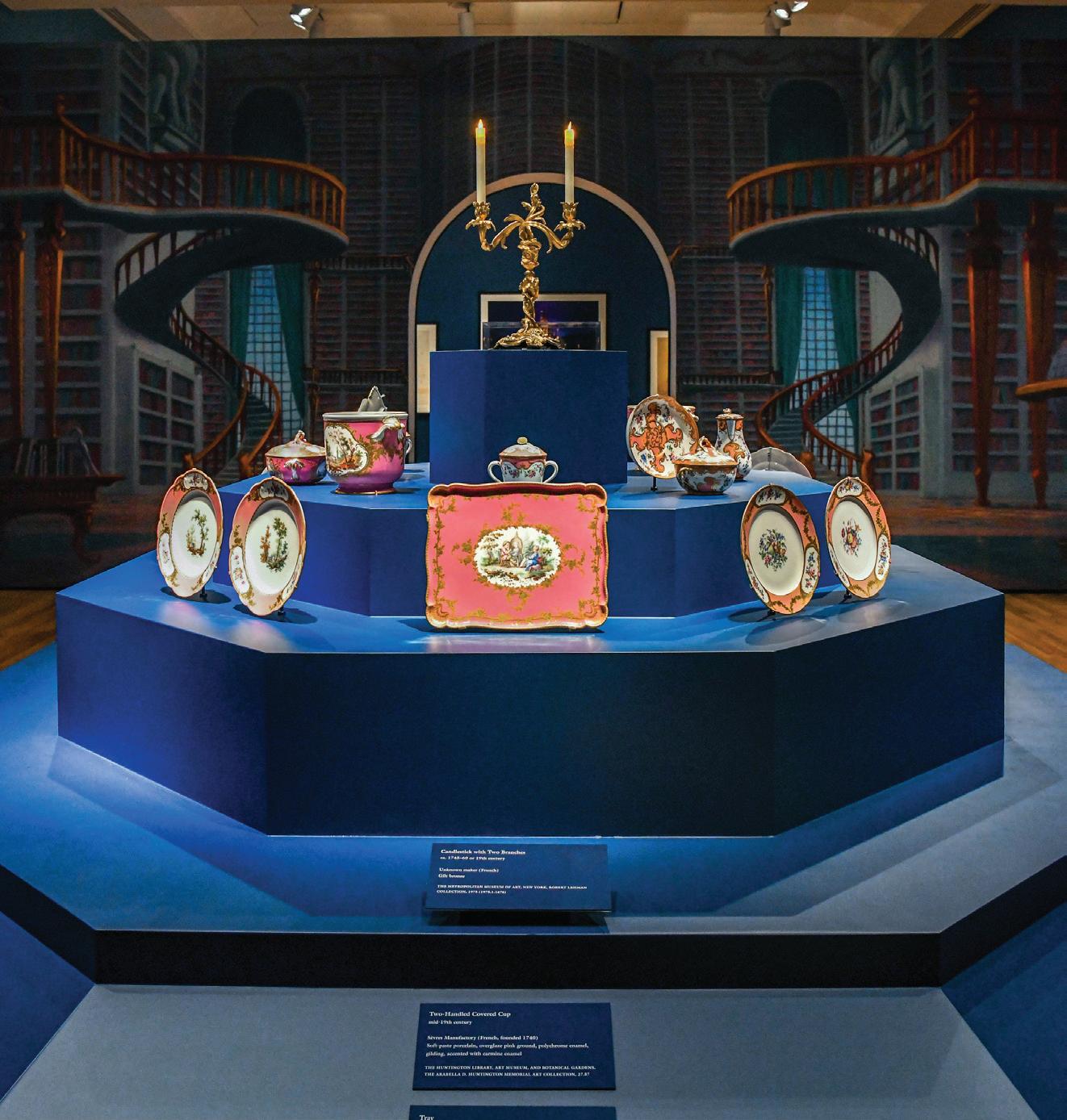
“The term ‘magic’ is one that was always associated in the 18th century, with porcelain and then later with Disney Animation. It’s something that the people had never seen before.”
“Inspiring Walt Disney: The Animation of French Decorative Arts”
WHEN: 10 a.m. to 5 p.m. through Monday, March 27; closed Tuesdays WHERE: The Huntington Library, Art Museum, and Botanical Gardens, 1151 Oxford Road, San Marino COST: $25 general admission; weekend and Monday holiday reservations required INFO: huntington.org

After 40 years, the Pasadena Showcase House for the Arts (PSHA) will return to Stewart House for the first time since 1983 for the nonprofit organization’s 58th Showcase House. The beloved annual event will feature the work of 32 interior and exterior designers, who will fill the walls of the 1933 grand colonial estate in Pasadena starting in April.


“I’ve been going to Showcase since I was in high school,” 2023 benefit chair Matt McIntyre said. “It’s an organization I’m very passionate about, and I’ve volunteered for many years as a community volunteer. … I was just very attracted to the mission of the organization, their commitment to arts and music education, and the programs that they offer for students.”
Since its founding in 1948, PSHA has given more than $24 million in support of music and arts programs. During the 2021-22 program year, the all-volunteer organization
contributed $500,000 to local nonprofits. The Pasadena Showcase House of Design is PSHA’s primary fundraising benefit.
“The three tenants that I’m trying to really stay focused on … that I’m working with for this year is ‘history,’ because I think the organization has such a long history in the community and at the same time respecting the history of the homes that we’re in,” McIntyre began. “‘Legacy,’ as we have a legacy of giving and we have these student programs that are very important to us as Showcase and to the communities that we serve. And then ‘community.’ Without the community, without Pasadena, without the greater San Gabriel Valley area, we wouldn’t be the successful Showhouse that we are.
“I think it’s really important to acknowledge that the Pasadena community is very dedicated to nonprofits but has been very dedicated to Showcase. And I really want to make this a special event for them. … I hope
that this benefit is our most successful benefit in history, and that’s my goal.”


Stewart House will be vacated, then reimagined by designers for the first time since its feature as the 19th Showcase House. The estate, designed by celebrated Pasadena architectural partnership Marston & Maybury, has over 11,000 square feet of living space sited on two acres of manicured landscape.
“It’s a house that I’ve driven by all my life, and I’ve always thought that it was such an impressive house,” McIntyre described. “So when the homeowners were interested, that was also compelling to me. … It’s been owned by the same family for the entire 40 years. So after the ’83 Showcase House, it sold to the present family and they’ve been there nearly 40 years.’
Over the course of four months, an array of designers will enter the home and renovate over 30 interior and landscape design spaces using their own individual visions for each section.
An estimated 20,000 guests will then tour through the property, which will also include the popular Shops at Showcase, with a variety of boutique and craft merchants, as well as on-site restaurants and live entertainment.

“All of those are important elements that make benefits successful,” McIntyre said. “I want the visitor to re-experience Showcase grandeur and to really enjoy the whole of the event. We have a lot of our legacy vendors coming back. … Some (have been) with us for decades at this point and are wildly popular in the community.
“Then the house … is colonial. We haven’t done a colonial house in a long time. It has a lot of rooms, which is nice because we can incorporate more designers. … You’re also able to attract younger or more cutting-edge designers that might just want a small space because asking somebody to take on a large space like the living room … is a pretty big commitment. It’s not for the faint of heart.”
McIntyre also expressed a hope that each of the featured designers can meet new people and expand their own businesses through the event, as their work will be exposed to a wide audience in a unique setting.
“One of the nice attributes for an interior designer about doing a Showcase House is they get to do something that’s truly reflective of them,” McIntyre explained. “They’re not really reporting to a client, so they don’t have all those layers of things that clients want. They get to be the artists that they really are.”
Public tours of Stewart House will take place from Sunday, April 23, to Sunday, May 21. Golden tickets are currently on sale and timed entry tickets will go on sale in early February. PSHA will also offer insider packages that give guests an insight into the transformation of Stewart House with access to the Empty House Party in January and Premiere Night Gala in April.
Pasadena Showcase House for the Arts’ 58th Showcase House WHERE: Stewart House, Pasadena
WHEN: Public tours run from Sunday, April 23, to Sunday, May 21.
INFO: pasadenashowcase.org
Soundgarden guitarist Kim Thayil admits he was a little skeptical the first time he heard of Rock ’n’ Roll Fantasy Camp.

But after participating as a special guest last year, he jumped at the chance to do it again this year.
The camp’s latest offering, A Whole Lotta Rock: From Led Zeppelin to Soundgarden to Stone Temple Pilots, features Thayil, Robert and Dean DeLeo of the Grammy-winning band Stone Temple Pilots, and Carmine Appice of Vanilla Fudge. It’s set for Thursday, March 16, to Sunday, March 19, in Los Angeles.
Other guests include Monte Pittman (Madonna), Joel Hoekstra (Whitesnake), Michael Kroeger (Nickelback), Brian Tichy (Ozzy), Black (Scott Weiland and the Wildabouts), Vinny Appice (Black Sabbath, Dio), Tony Franklin (The Firm), Britt Lightning (Vixen), Teddy Zigzag (Guns N’ Roses), Jason Ebs (Peter Criss) and Adam Kury (Candlebox).
Included at Rock ’n’ Roll Fantasy Camp are performances at the Viper Room and the Whisky a Go Go, the latter of which features Thayil.
Now celebrating its 25th anniversary, Rock ’N’ Roll Fantasy Camp has become part of American popular culture — from a Mick Jagger cameo in “The Simpsons” to “Rock Camp: The Movie.” It extracts ordinary people from their daily lives and allows them to perform with their musical heroes.
“The people who worked around the organization were fantastic. The fans were great. The campers were polite and eager, and many were very talented,” Thayil says.
“We all had friends like this: They hang out in their basements or their bedrooms learning all the Zeppelin songs or Hendrix songs. In the ’80s, it would have been Van Halen. They were the best guitarists you knew in school. We met a few of those dudes. They were really talented.”
Some of the players were nervous because it was the first time hitting the stage or performing with a band. Thayil says it’s a “bit of a challenge but rewarding.”
“Growing up, you hear about rock school, which is still goofy to me,” he says.
“There’s an aspect of attitude and independence and freedom that can’t necessarily be taught. You can teach people to cooperate in a collaborative manner. That’s perhaps the most important part. That was a good thing. The idea of rock schools or baseball fantasy camps or rock fan camp, something about that seemed awkward growing up. The idea of trying to teach something that might be counterculture or rebellious is counterintuitive of how rock is.”
The COVID-19 pandemic convinced him otherewise. It was a time when peers and friends were suddenly unemployed.
“The crews who worked for us or Pearl Jam, say, had to find other work to do,” he recalled. “Clubs and venues closed. Promoters, security, bartenders, they were out of gigs. When the offer came in (for camp), I had no good reason to reject an opportunity to work in the pandemic.
“I didn’t think it was good form when your friends are hoping to go on tour.”
Thayil says he really enjoyed the volunteers and camp counselors, as well as the spirit of camaraderie among them.
Speaking of camaraderie, Thayil is playing recreationally again in the band 3rd Secret with bassist/accordionist Krist Novoselic (Nirvana), drummer Matt Cameron (Pearl Jam/Soundgarden), guitarist Jon “Bubba” Dupree (Void), and vocalists Jillian Raye and Jennifer Johnson.
“Krist called me up and says, ‘Hey, there are some old songs you and I did 20 years ago. Want to revisit some of those songs?’” he recalls.
“Matt brought in some demos. There’s no hard push professionally, no management, no accountants, no lawyers. It’s all just for fun. We record songs and post them for streaming.”
It mirrors the attitude Thayil had the first time Soundgarden broke up, he says.
“I didn’t want to call up managers, lawyers, record company people. I didn’t want to have to start again with soliciting,” Thayil adds.
“I just played when I could and drank beer and turned the amps up. We were just three guys in an attic with three stringed instruments — well, two and a couple amps — and neighbors who told us to turn it down after 10.”
That relates to Thayil’s best advice he can give to prospective camp participants.
“Don’t stress, and don’t overwork yourself,” he explains. “If you overstress and overwork yourself, that’ll affect performance. Don’t worry about the performance. You’re with other people. In reality, you probably have the same kind of jitters on stage as everybody else, unless you’re a complete hot dog.”
Thayil called himself a bit of a hot dog and a little nervous.
“It depends,” he says with a laugh. “If you get a couple beers in me, I’m a little bit more exhibitionistic and hot doggy. Most of the time, I’m a little bit nervous until a few songs go by. It’s pretty cool to share those experiences with the DeLeos and Carmine Appice, one of those great drummers we talked about since I was a kid.”
Rock ’n’ Roll Fantasy Camp: A Whole Lotta Rock: From Led Zeppelin to Soundgarden to Stone Temple Pilots
WHEN: Various times Thursday, March 16, to Sunday, March 19

WHERE: Los Angeles COST: $599 holds a spot INFO: 1-888-762-2263, rockcamp.com
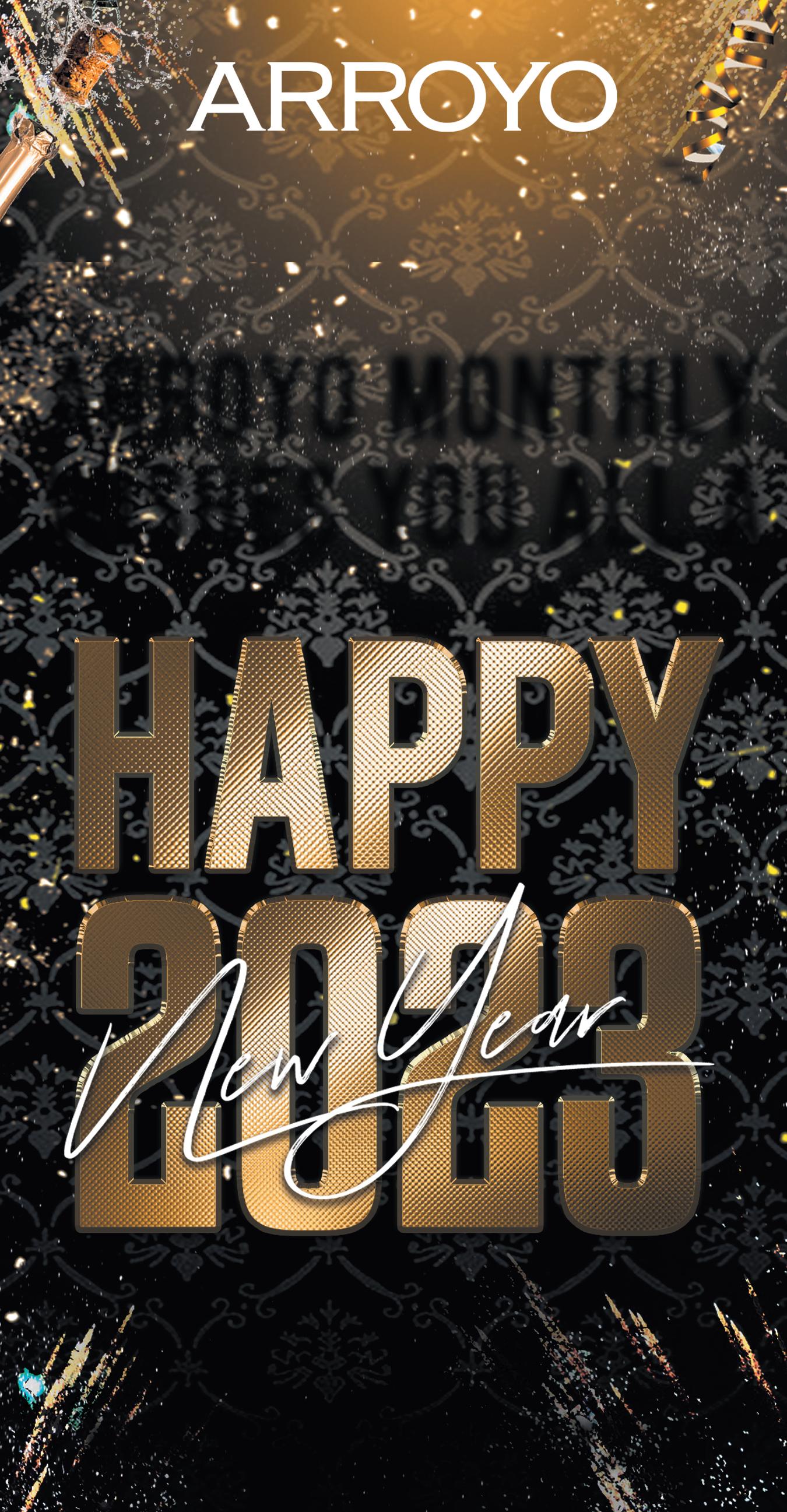
Satien Mehta won an MTV VMA for producing Fall Out Boy’s “Uma Thurman” music video and has worked with Grammy Award-winning artists and international brands like Jack Daniel’s, Kaiser Permanente and Universal Music Group.
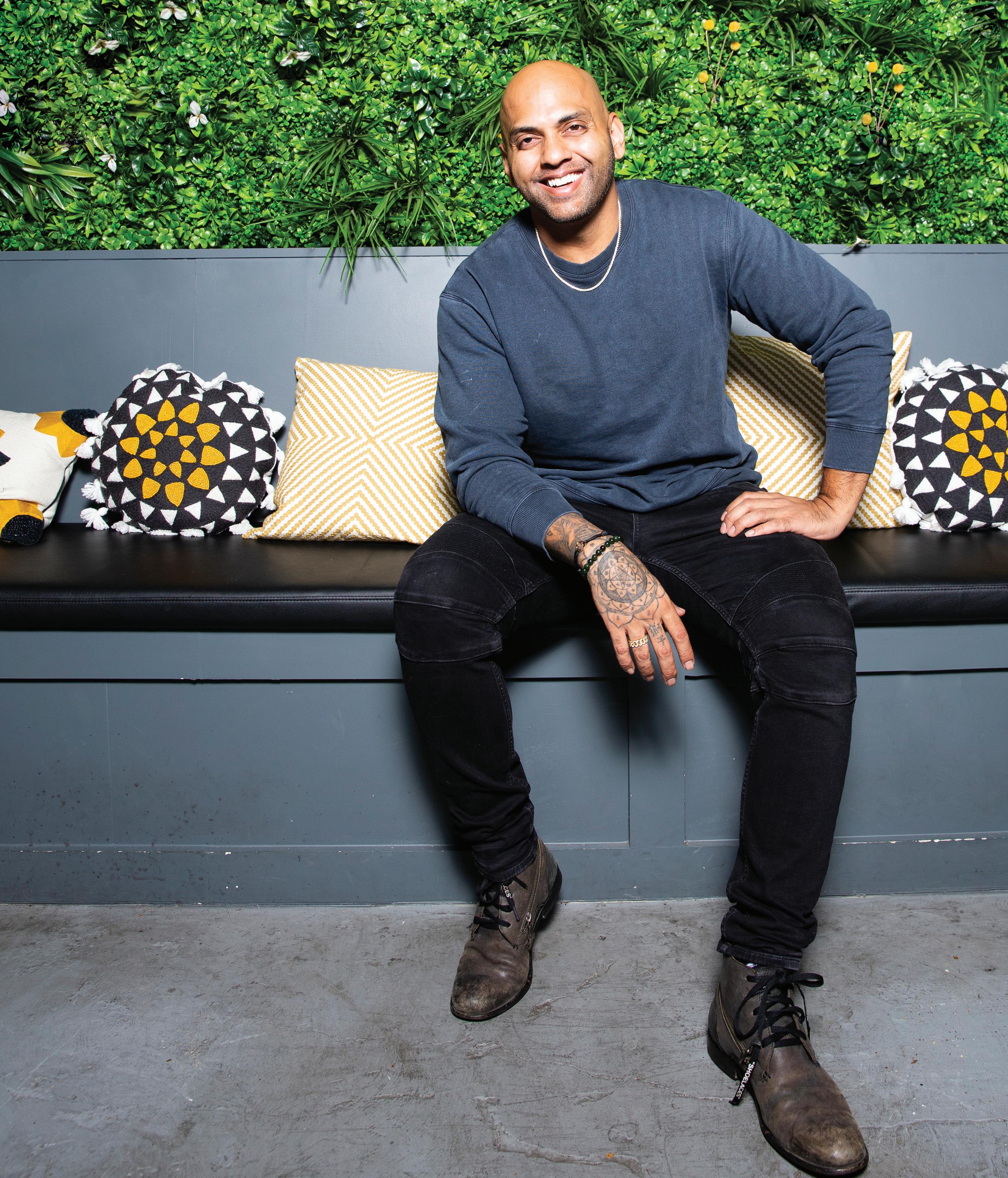
Recently, he’s been producing projects for Halsey and her makeup line, About Face, and directed a Jay Pharoah music video.
He attributed it all to being at the right place at the right time.
“My career has been interesting,” says Mehta of Pasadena. “I feel like it’s been a chain of random things that just happened.”
He “fell into” his career after interning for Universal Music Group from August to December 2006 and Sony BMG from August to December 2007. The first video he worked on — “Tie Me Down” by New Boyz featuring Ray J. — went to No. 1 on MTV. He served as the production coordinator.
Mehta’s resume also includes stints with Stampede Management in artist development; Tommy Hilfiger; Prodigy Management in artist management; as the first A&R in the United States for Circus Records; and, since 2016, as a producer/owner of Drive International Agency.
“I decided in 2016 to focus 100% on producing,” he says. “I’ve worked mainly on hip-hop and electronic, small and big businesses. I want to focus on corporate and the commercial side of things. I’ve been working with Kaiser Permanente for the last four years.”
Mehta grew up in Phoenix and lived in Beaverton, Oregon, and San Diego, where he attended the University of San Diego. He moved to LA in 2009.
“After that, it was like ‘Grand Theft Auto,’” he says. “My son was 4 years old, and it wasn’t safe for us to be in the area. I looked for a part of town that was good for us. Pasadena has been the best place.”
Now, he’s searching for his next project. He’s entertaining the idea of recruiting the help of a venture capitalist. Mehta has not accepted funds before, so he’s a little hesitant. He built Drive International Agency from scratch. The single father says he has put millions of dollars back into the city by employing local crews.
“I’m looking at the universe and asking for guidance,” he says.
“I’ve peaked in my independent space. I’ve been in talks with a venture capitalist recently. He’s interested in helping me raise money to build out my company more than just me and my assistant.
“I’ve always prided myself on the standards and the customer service I provide. About 99% of my business has been referrals.”
Mehta does treasure his time with the likes of Fall Out Boy. The VMA, which the team shares, is in the band’s management office.
“They’re really nice guys,” Mehta says. “We spent four or five days with them. It was like organized chaos, basically. The executive producer, who was a friend of mine, called and said he had never done a music video before. This was on a Friday afternoon, and they were going to start filming on Monday.”
Within six hours, he found a tank, obtained insurance and a location for a scene in which the vehicle runs over a car.
“They were going to scrap that part, but I said, ‘Give me six or seven hours,’” he recalls. “I did everything, and we locked in the tank. There was a lot of stuff with insurance that I had to deal with, but it worked out great.”
Satien Mehta
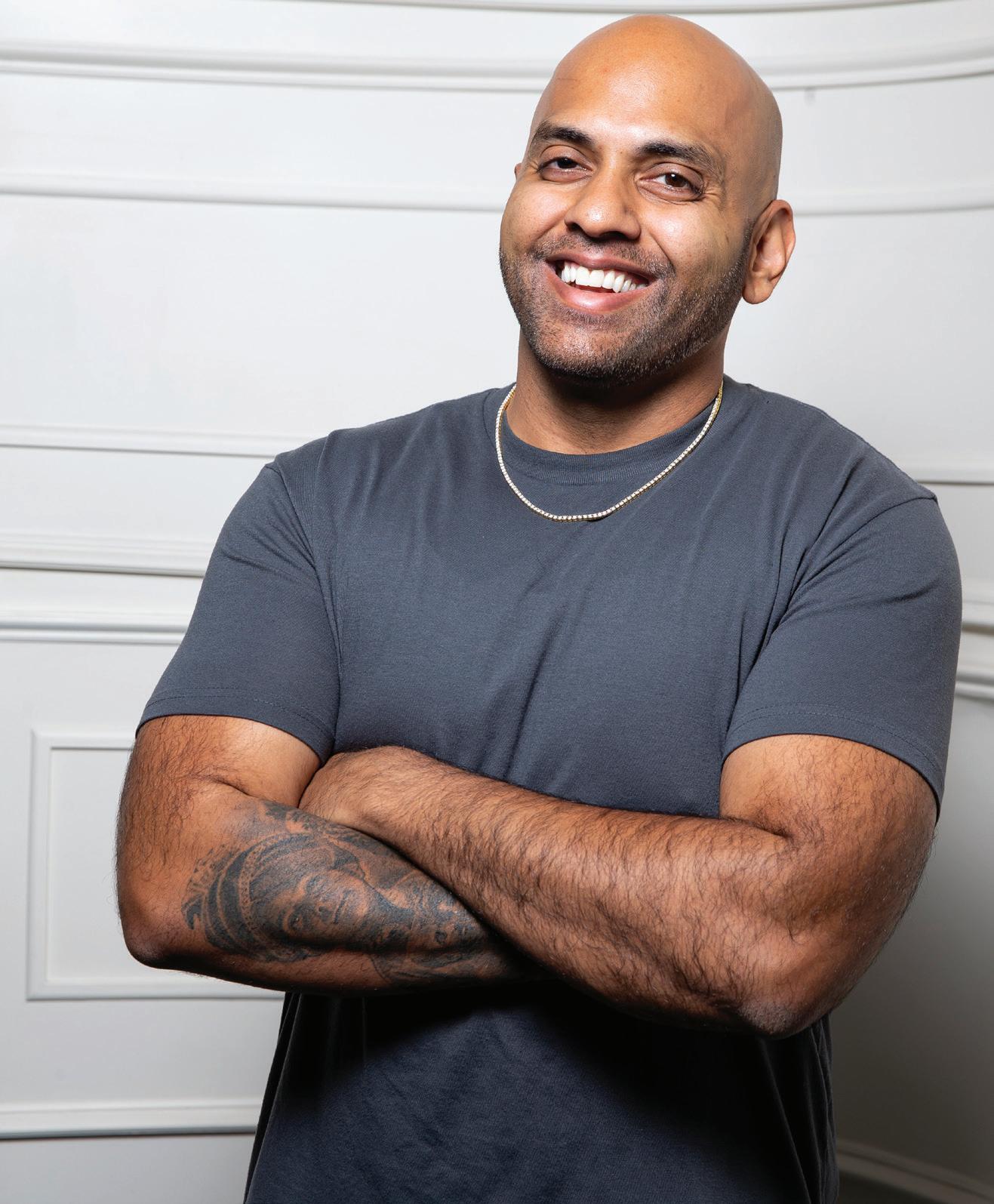
Instagram: satien_mehta
TikTok: @sattheproducer
The renowned bookstore Vroman’s is hosting more top-notch virtual and in-person programs throughout January. Vroman’s in-person events are no longer ticketed but are free and open to the public. Masks are strongly encouraged for those attending our events.
All in-person events will all be held at Vroman’s located at 695 E. Colorado Boulevard, Pasadena, unless otherwise noted.
Register through vromansbookstore.com. Anyone with questions is asked to email email@vromansbookstore.com.
Aubrey Gordon, in conversation with Evette Dionne, discusses “You Just Need to Lose Weight and 19 Other Myths about Fat People” 6 p.m. Tuesday, January 17
To register: crowdcast.io/e/aubreygordon
The pushback that shows up in conversations about fat justice takes exceedingly predicable form. Losing weight is easy — calories in, calories out. Fat people are unhealthy. There’s an obesity epidemic. Fat acceptance “glorifies obesity.” The BMI is an objective measure of size and health. Yet, these myths are as readily debunked as they are pervasive.
In “You Just Need to Lose Weight,” Aubrey Gordon equips readers with the facts and figures to reframe myths about fatness in order to dismantle the anti-fat bias ingrained in how we think about and treat fat people. Bringing her dozen years of community organizing and training to bear, Gordon shares the rhetorical approaches she and other organizers employ to not only counter these pernicious myths but to dismantle the anti-fat bias that so often underpin them.
As conversations about fat acceptance and fat justice continue to grow, “You Just Need to Lose Weight” will be essential to ensure that those conversations are informed, effective, and grounded in both research and history.
Vroman’s Live presents Clarence Lusane discussing “Twenty Dollars and Change: Harriet Tubman and the Ongoing Fight for Racial Justice and Democracy” 6 p.m. Thursday, January 19
To register for this event: crowdcast.io/e/clarencelusane America is in the throes of a historic reckoning with racism, with the battle for control over official narratives at ground zero. Across the country, politicians, city councils and school boards are engaged in a highly polarized debate about whose accomplishments should be recognized and whose point of view should be included in the telling of America’s history.
In “Twenty Dollars and Change,” political scientist Clarence Lusane, author of the acclaimed “The Black History of the White House,” writes from a basic premise: Racist historical narratives and pervasive social inequities are inextricably linked — changing one can transform the other. Taking up the debate over the future of the $20 bill, Lusane uses the question of Harriet Tubman vs. Andrew Jackson as a lens through which to view the current state of our nation’s ongoing reckoning with the legacies of slavery and foundational white supremacy. He places the struggle to confront unjust social conditions in direct connection with the push to transform our public symbols, making it plain that any choice of whose life deserves to be remembered and honored is a direct reflection of whose basic rights are deemed worthy of protection and whose are not.
Mehta relocated to Pasadena from Downtown LA after COVID-19 hit and the George Floyd demonstrations began.Alex Kenna discusses “What Meets the Eye: A Mystery”
7 p.m. Thursday, January 5
Kate Myles was a promising Los Angeles police detective, until an accident and opioid addiction blew up her family and destroyed her career. Struggling to rebuild her life, Myles decides to try her hand at private detective work — but she gets much more than she bargained for when she takes on the case of a celebrated painter found dead in a downtown loft.
When Margot Starling’s body was found, the cause of death was assumed to be suicide. Despite her beauty, talent and fame, she struggled with a host of demons. But as Myles digs deeper, she learns that Starling had a growing list of powerful enemies — among them a shady art dealer who had been selling forged works by Starling. Myles soon uncovers a dirty trail that leads straight into the heart of the city’s deadly underworld.
Starling died for her art — and if Myles doesn’t tread lightly, she could be the next to get brushed out.
Jeri Westerson discusses “Courting Dragons”

7 p.m. Friday, January 6
1529, London. Jester Will Somers knows all of King Henry VIII’s secrets. But when he discovers a body in a courtyard at Greenwich Palace, and a blackmail note arrives soon after demanding information about the king, can he prevent one of his own closely guarded secrets being exposed while also thwarting a plot against the monarch?
Iris Yamashita discusses “City Under One Roof”
7 p.m. Tuesday, January 10
When a local teenager discovers a severed hand and foot washed up on the shore of the small town of Point Mettier, Alaska, Cara Kennedy is on the case. A detective from Anchorage, she has her own motives for investigating the possible murder in this isolated place, which can be accessed only by a tunnel.
After a blizzard causes the tunnel to close indefinitely, Kennedy is stuck among the odd and suspicious residents of the town — all 205 of whom live in the same high-rise building and are as icy as the weather. Kennedy teams up with Point Mettier Police Officer Joe Barkowski, but before long the investigation is upended by fearsome gang members from a nearby native village.
Haunted by her past, Kennedy soon discovers that everyone in this town has something to hide. Will she be able to unravel their secrets before she unravels?
W. Bruce Cameron discusses “Love, Clancy: Diary of a Good Dog”

7 p.m. Wednesday, January 11
You’ve probably never met someone like Clancy. He’s keeping a diary, he’s falling in love, there are rivals for his affections, he lives with his best friend and his worst enemy — even taken together, these factors are maybe not that unusual, except that Clancy is a dog. His point of view is therefore perhaps… different.
Told in W. Bruce Cameron’s signature style, a tremendous cast of wonderful characters find themselves jointly and separately navigating the challenges of life, of love and… other pets, including Clancy’s “worst enemy” — one
very disdainful cat. It’s a lot to keep track of, especially when things start to spin hilariously out of control, but fortunately, we’ve got the observations of Clancy, a very good dog, who shares a valuable perspective on what is really important.
Pico Iyer, in conversation with Alison Singh Gee, discusses “The Half Known Life: In Search of Paradise”
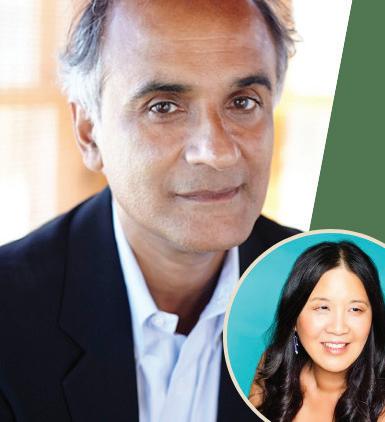
7 p.m. Friday, January 13
Paradise: that elusive place where the anxieties, struggles and burdens of life fall away. Most of us dream of it, but each of us has very different ideas about where it is to be found. For some it can be enjoyed only after death; for others, it’s in our midst — or just across the ocean — if only we can find eyes to see it.
Traveling from Iran to North Korea, from the Dalai Lama’s Himalayas to the ghostly temples of Japan, Pico Iyer brings together a lifetime of explorations to upend our ideas of utopia and ask how we might find peace in the midst of difficulty and suffering. Does religion lead us back to Eden or only into constant contention? Why do so many seeming paradises turn into warzones? And does paradise exist only in the afterworld — or can it be found in the here and now?
For almost 50 years Iyer has been roaming the world, mixing a global soul’s delight in observing cultures with a pilgrim’s readiness to be transformed. In this culminating work, he brings together the outer world and the inner to offer us a surprising, original, often beautiful exploration of how we might come upon paradise in the midst of our very real lives.
Vroman’s presents Deb Perelman, in conversation with Alyse Whitney, discussing “Smitten Kitchen Keepers: New Classics for Your Forever Files: A Cookbook” 7 p.m. Wednesday, January 18
The long-awaited new book from the bestselling and beloved author of “The Smitten Kitchen Cookbook” — a collection of essential recipes for meals you’ll want to prepare again and again. Deb Perelman is the author of two bestselling cookbooks, the OG of the culinary blogosphere, the homegrown brand with more than a million Instagram followers, the self-taught cook who obsessively tests her recipes until they’re perfect. Here, in her third book, Perelman presents 100 new recipes (plus a few old favorites from her site) that aim to make shopping easier, preparation more practical and enjoyable, and food more reliably delicious for the home cook. What’s a keeper? It’s a brilliantly fuss-free lemon poppy seed cake. It’s Perelman’s favorite roasted winter squash. It’s an epic quiche. It’s a slow-roasted chicken on a bed of unapologetically schmaltzy croutons. It’s the only apple crisp she will personally ever make. It’s perfect spaghetti and meatballs. These are the fail-safe, satisfying recipes you’ll rely on for years to come — from Perelman’s forever files to yours.
This ticketed event will take place at Pasadena Presbyterian Church located at 585 E. Colorado Boulevard, Pasadena. There are two ticket options. One will include a copy of “Smitten Kitchen Keepers” to be handed out at check-in, and the second option is for event entry only.

To purchase tickets, visit eventbrite.com.
Daniel Suarez discusses “Critical Mass”
6:30 p.m. Tuesday, January 24
In New York Times bestselling author Daniel Suarez’s latest space-tech thriller, a group of pioneering astropreneurs must overcome never-beforeattempted engineering challenges to rescue colleagues stranded at a distant
asteroid — kicking off a new space race in which Earth’s climate crisis could well hang in the balance.
When unforeseen circumstances during an innovative — and unsanctioned — commercial asteroid-mining mission leave two crew members stranded, those who make it back must engineer a rescue, all while navigating a shifting web of global political alliances and renewed Cold War tensions. With Earth governments consumed by the ravages of climate change and unable to take the risks necessary to make rapid progress in space, the crew must build their own nextgen spacecraft capable of mounting a rescue in time for the asteroid’s next swing by Earth.
In the process, they’ll need to establish the first spin-gravity station in deep space, the first orbiting solar power satellite and refinery, and historic infrastructure on the moon’s surface — all of which could alleviate a deepening ecological, political and economic crisis back on Earth, and prove that space-based industry is not only profitable, but possibly humanity’s best hope for a livable, peaceful future.
Jordan Harper, in conversation with SA Crosby, discusses “Everybody Knows” 7 p.m. Wednesday, January 25
Welcome to Mae Pruett’s Los Angeles, where “Nobody talks. But everybody whispers.” As a “black-bag” publicist tasked not with letting the good news out but keeping the bad news in, Pruett works for one of LA’s most powerful and sought-after crisis PR firms, at the center of a sprawling web of lawyers, PR flaks and private security firms she calls “The Beast.” They protect the rich and powerful and depraved by any means necessary.
After her boss is gunned down in front of the Beverly Hills Hotel in a random attack, Pruett takes it upon herself to investigate and runs head first into The Beast’s lawless machinations and the twisted systems it exists to perpetuate. It takes her on a roving neon joyride through a Los Angeles full of influencers pumped full of pills and fillers, sprawling mansion footsteps away from sprawling homeless encampments, crooked cops and mysterious wrecking crews in the middle of the night.
Edgar Award-winner Jordan Harper’s “Everybody Knows” is addicting and alarming, a “juggernaut of a novel” and “an absolute tour de force.” It is what the crime novel can achieve in the modern age: portray the human lives at the center of vast American landscapes and make us thrill at their attempts to face impossible odds.
Sarah Eagle Heart and Emma Eagle Heart-White discuss “Warrior Princesses Strike Back: How Lakota Twins Fight Oppression and Heal Through Connectedness”

7 p.m. Thursday, January 26
Interspersing personal memoir with radical notions of self-help and collective recovery, “Warrior Princesses Strike Back” focuses how Indigenous activist strategies can be a crucial roadmap for contemporary truth and healing.
Pine Ridge Indian Reservation is home to the original people of this land, yet it is also one of the poorest communities in America. Through intimate and vulnerable memoir, Lakota twin sisters Sarah Eagle Heart and Emma Eagle Heart-White recount growing up on the reservation and overcoming enormous odds, first as teenage girls in a majority-white high school and then battling bias in their professional careers. Woven throughout are self-help strategies centering women of color that combine marginalized histories, psychological research on trauma, and perspectives on decolonial therapy. Through the lens of Indigenous activism, the Eagle Hearts explore the possibility of healing intergenerational and personal trauma by focusing on tradi-
tional strategies of reciprocity, acknowledgment and collectivism.
Vroman’s Local Author Day featuring Sean Garrett, Barry Schweiger and Michael Bell

4 p.m. Sunday, January 29
Michael Bell presents “Seller Mistakes” “Seller Mistakes: What You Were Never Told about Selling Your Home and Why It Should Matter to You” is a powerful book that reveals what the real estate industry doesn’t want you to know when you are selling your home. Hundreds of thousands of homeowners try, but fail, to sell their home. Why? Simply, it’s almost always because of big mistakes that their agent made.
This is a completely different kind of real estate book. It will agitate most agents because it shines the light on a very hard truth: things that appear to work for the seller are really only serving the agent — often at tremendous expense to the seller.
Prepare to understand what it really takes to sell your home quickly and at top dollar. And learn how to avoid headaches by sidestepping the mistakes that most agents don’t even know about.
“The Resurrection of Jesus Christ” is a compelling fictional novel that retraces the events of the trial of Jesus Christ, through the eyes of Pontius Pilate, and sheds new light on the aftermath surrounding Jesus’ death and resurrection. The Jews have delivered Jesus to Pilate and, with him, a host of allegations in which they fail to establish proof that Jesus should be put to death. Even Pilate, after hearing testimony from all sides, including Jesus himself, cannot side with Caiaphas, Annas and the rest of the Jews, who demand that Jesus be given death by the cross. The trial is highly contentious and personal, and at one point, Pilate fears that the calm of the approaching Passover would be disrupted with riot and insurrection by the angry Jews, if he does not act according to their demands. Thus, Pilate makes a political and fateful decision to condemn Jesus, despite the lack of evidence to convict him of the crimes against him. Pilate’s decision to put Jesus to death sets off a chain of events that would challenge Pilate’s decision to its core. Pilate, subsequently, finds himself in a life-changing conflict that would force him to question his beliefs, his morality, and his allegiance to Tiberius and the Roman Empire.
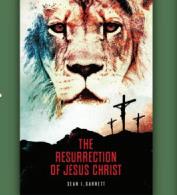
Barry Schweiger presents “Rockitecture”
“Rockitecture” is a journey of the building and endurance of Southern California’s river rock homes, churches, castles, waiting stations and water troughs-architecture crafted from the Golden State’s indigenous, natural materials during the late 1800s and early 1900s. The book explores the foothills, alluvial fans and new towns where these masterpieces were made, the men who made them and the lessons we can learn. It celebrates and pays tribute to history, ancestors, native landscapes and craftsmanship that endure for generations.
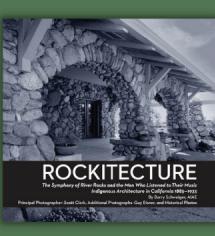
Kathryn Ross discusses “Black Was Not a Label”
7 p.m. Tuesday, January 31
“Black Was Not a Label” is a collection of essays that explores the intersection of faith and racial trauma and the attempt to come to terms with instances of otherness, isolation, racism, erasure, anger and lost love. A look at life within the “veil” W.E.B. Du Bois spoke of in his work, “The Souls of Black Folk,” this collection is both catharsis and lamentation to God for the self and all who have felt trapped within this (sometimes impenetrable) veil.
The Pasadena Senior Center, 85 E. Holly Street, hosts free events and activities for anyone 50 and older — members and nonmembers.
Registration for Zoom activities and most on-site events is required by visiting pasadenaseniorcenter.org and clicking on “activities & events,” “lectures & classes” or “resources.”
Everyone who registers for Zoom events will receive an email link for joining each activity online. Most Zoom events are recorded and televised on the Pasadena Senior Center YouTube channel. COVID-19 protocols are observed for all on-site events at the center.
Proof of vaccination is required for anyone who attends on-site events indoors or uses the fitness center. Masks are recommended but not required.
“Learn What Your Mobile Device Can Do” | 10 a.m. Thursday, January 5 | Zoom
Mobile devices (smartphones and tablets) can be challenging, but with this program, participants can learn how to use contacts, email and other features. That includes apps for social media, video games, movies, photo editing and preparing tax returns. Presented by Pete Matus, who also will answer your questions. To register or for more information, visit pasadenaseniorcenter.org and click on “lectures & classes,” then “informational lectures,” or call 626-795-4331.
Legal Consultations
10 a.m. to noon Thursday, January 5 | Pasadena Senior Center
Learn about wills and trusts, conservatorships, durable powers of attorney, and estate planning. To schedule a required appointment, call 626-795-4331.
1 p.m. Fridays in January Pasadena Senior Center
Each Pasadena Senior Center member who registers may bring one
nonmember guest.
January 6: “Love Actually” (2003, R) starring Hugh Grant and Laura Linney. Eight very different couples deal with their love lives in various interrelated tales set during a frantic month before Christmas in London.
January 13: “Selma” (2014, PG-13) starring David Oyelowo and Carmen Ejogo. Despite violent opposition among white southerners, Dr. Martin Luther King Jr. leads an epic march in Alabama from Selma to Montgomery in 1965 to secure equal voting rights.
January 20: “The Second Mother” (2015, R) starring Regina Casé and Helena Albergaria. When the estranged daughter of a hard-working live-in housekeeper suddenly appears, unspoken class barriers that exist in the home are thrown into disarray. Spanish with English subtitles.
January 27: “My Big Fat Greek Wedding” (2002, PG) starring Nia Vardalos and John Corbett. A young Greek American woman falls in love with a non-Greek man and struggles to get her family to accept him while she comes to terms with her heritage and cultural identity.
To register for any or all of these movies or for more information, visit pasadenaseniorcenter.org and click on “activities & events” and “Friday Movie Matinee” or call 626-7954331.
Chair Yoga
11 a.m. Tuesday, January 10 Zoom
Improve balance, strength, flexibility and well-being while sitting on a chair or standing while using a chair for support during this gentle and meditative class. For more information, visit pasadenaseniorcenter.org and click on “lectures & classes,” then workshops, or call 626-7954331.
It’s Never Too Late to Play the Ukulele | 10 a.m. Thursday, January 12 | Zoom
Learn how simple it is to play the ukulele and how it can give you a renewed appreciation and perspective for bringing music into your life. Presented by Melanie Kareem, founder and creative director at Get Started Playing the Ukulele. To register or for more information, visit pasadenaseniorcenter.org and click on “lectures & classes,” then “informational lectures,” or call 626-795-4331.
Standards and Show Tunes with Bob and Don | 2 p.m. Thursday, January 12 Pasadena Senior Center
Join pianist Bob Lipson and singer Don Snyder with special guest bassist David Young for an afternoon of music featuring showtunes and standards. This event will take place indoors. To register or for more information, visit pasadenaseniorcenter. org and click on “activities & events,” then “special events,” or call 626795-4331.
What You Should Know About Scams 10 a.m. Thursday, January 19 Zoom
Learn about insurance fraud and scams that target older adults and how to fight back and protect yourself. Presented by California Department of Insurance. To register or for more information, visit pasadenaseniorcenter.org and click on “lectures and classes,” then “informational lectures,” or call 626-795-4331.
Health Fair and Fresh Produce Distribution 9 to 11 a.m. Friday, January 20 Pasadena Senior Center
While supplies last. Health fair services indoors will include blood pressure and glucose testing, hearing tests, updates in Medicare health plans, and resources. Preassembled bags of fresh, nutritious vegetables will be distributed on the patio while supplies last courtesy of Order of Malta Mobile Ministries. Everyone is encouraged to bring a bag or personal pull-behind cart to transport the produce home. Registration is not required. For more information, call 626-795-4331.
Aging and Hearing Health 10 a.m. Thursday, January 26 Zoom
Age-related hearing loss can be gradual. Education and early detection can improve hearing thresholds
significantly. Learn how to achieve hearing health as you age, the implications of hearing loss, its association with memory decline, and other risk factors. Presented by Foundation for Senior Services. To register, visit pasadenaseniorcenter.org and click on “lectures & classes,” then “informational lectures,” or call 626-795-4331.
Mediation and Dispute Resolution
10 a.m. to noon Thursday, January 26 | Pasadena Senior Center
Learn how to resolve conflicts with the help of a trained mediator, including property ownership, landlord/tenant disputes, workplace/employment issues and family disagreements. Presented by Loyola Center for Conflict Resolution. To make an appointment, call 626-795-4331.
Electronic Waste Collection Day 9 a.m. to 4 p.m. Tuesday, January 31
Pasadena Senior Center
Drop off old electronic equipment at the Pasadena Senior Center patio for recycling in an environmentally responsible manner. Bring TVs, monitors, medical equipment, smartphones, PCs, monitors, printers, laptops, tablets, radios/stereos and other related equipment. Volunteers will be on hand to assist. Reservations are not required for this event. For more information, call 626-795-4311.
2 p.m. Thursday, February 2 Pasadena
The Year of the Rabbit will be ushered in at the Pasadena Senior Center with a traditional lion dance, martial arts demonstrations and other activities.
In addition to online classes, onsite events and more, members and nonmembers of the Pasadena Senior Center are encouraged to visit the website regularly for a quarterly online magazine, free food delivery for older adults in need, and COVID-19 updates specifically for older adults.
The center is an independent, donor-supported nonprofit organization that has served older adults for more than 60 years. During the pandemic, doors are open Mondays through Fridays from 8:30 a.m. to 4:30 p.m. for social services as well as the library, Sy Graff Fitness Center, computer lab, and limited occupancy for events. Rooms are sanitized after each use.




Walk-ins are welcomed, or call to schedule an appointment today. Please enjoy our free parking. 474 S Arroyo Pkwy, Pasadena, CA 91105 | (626) 314-2994 | Noblessa-USA.com/Pasadena

